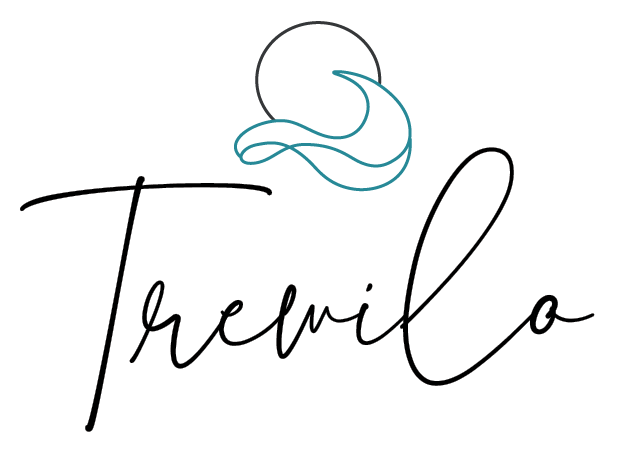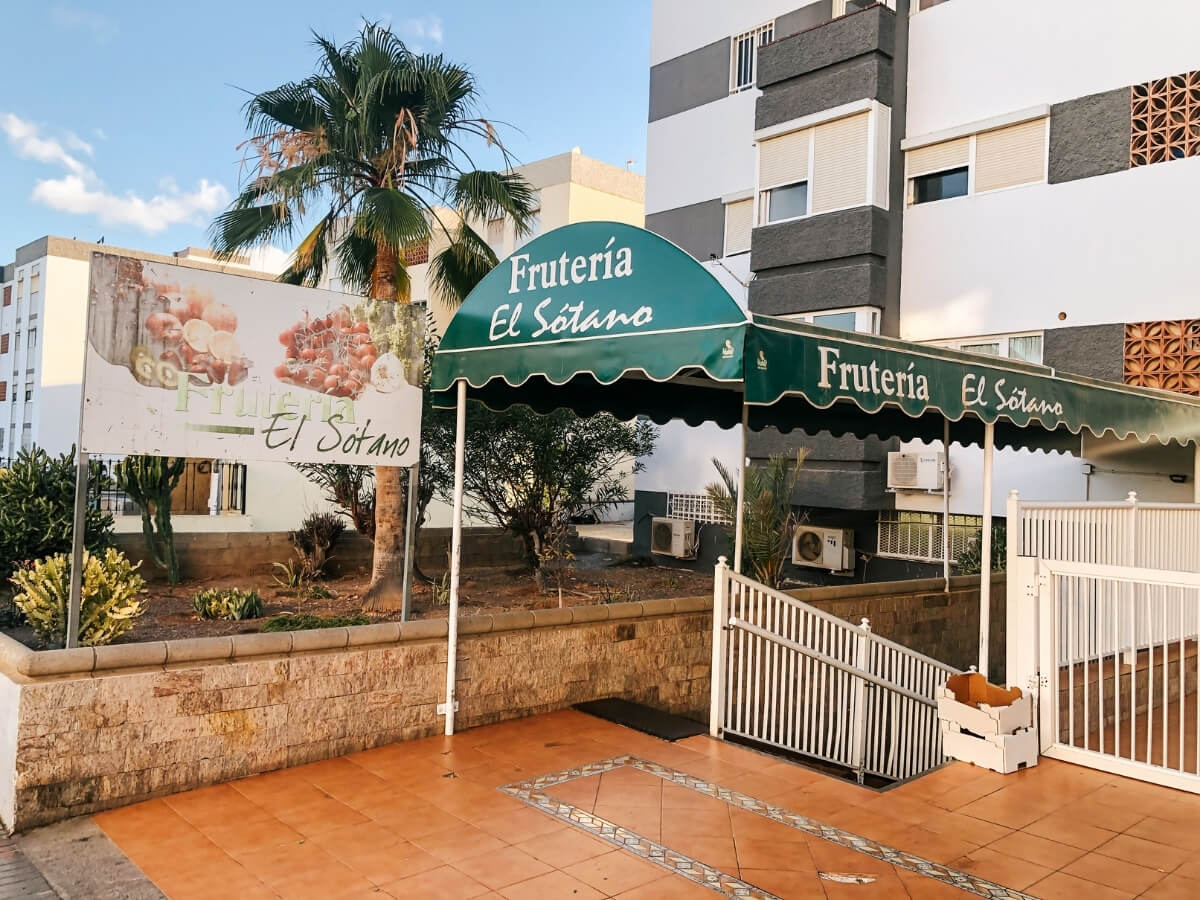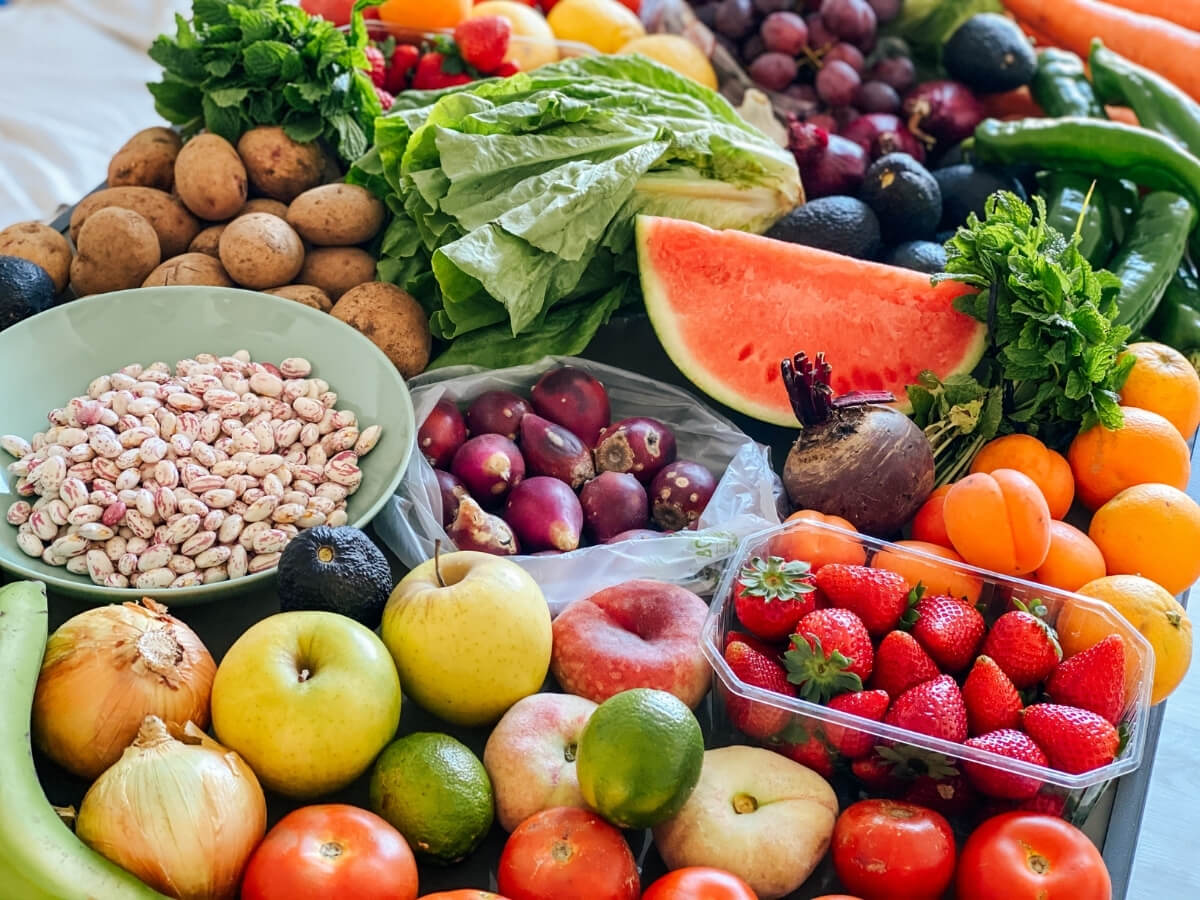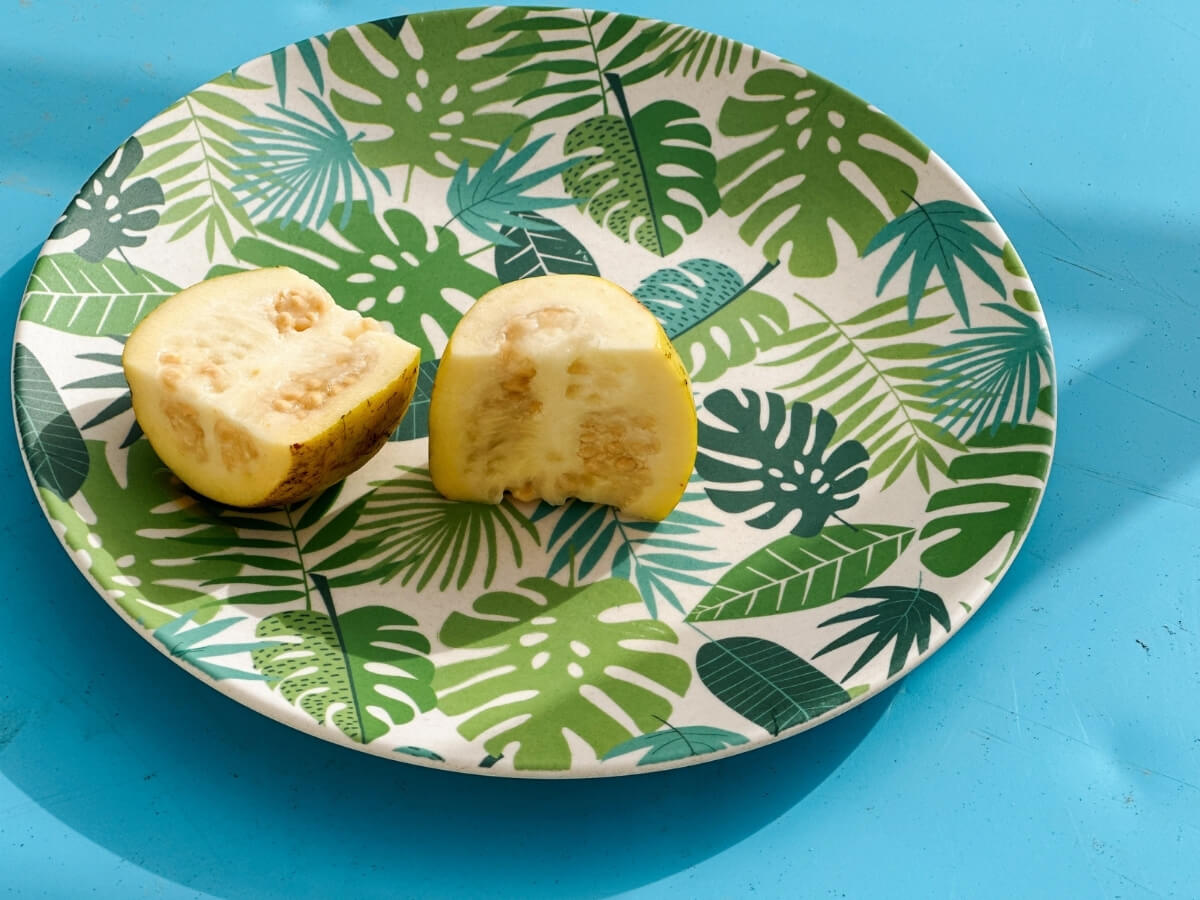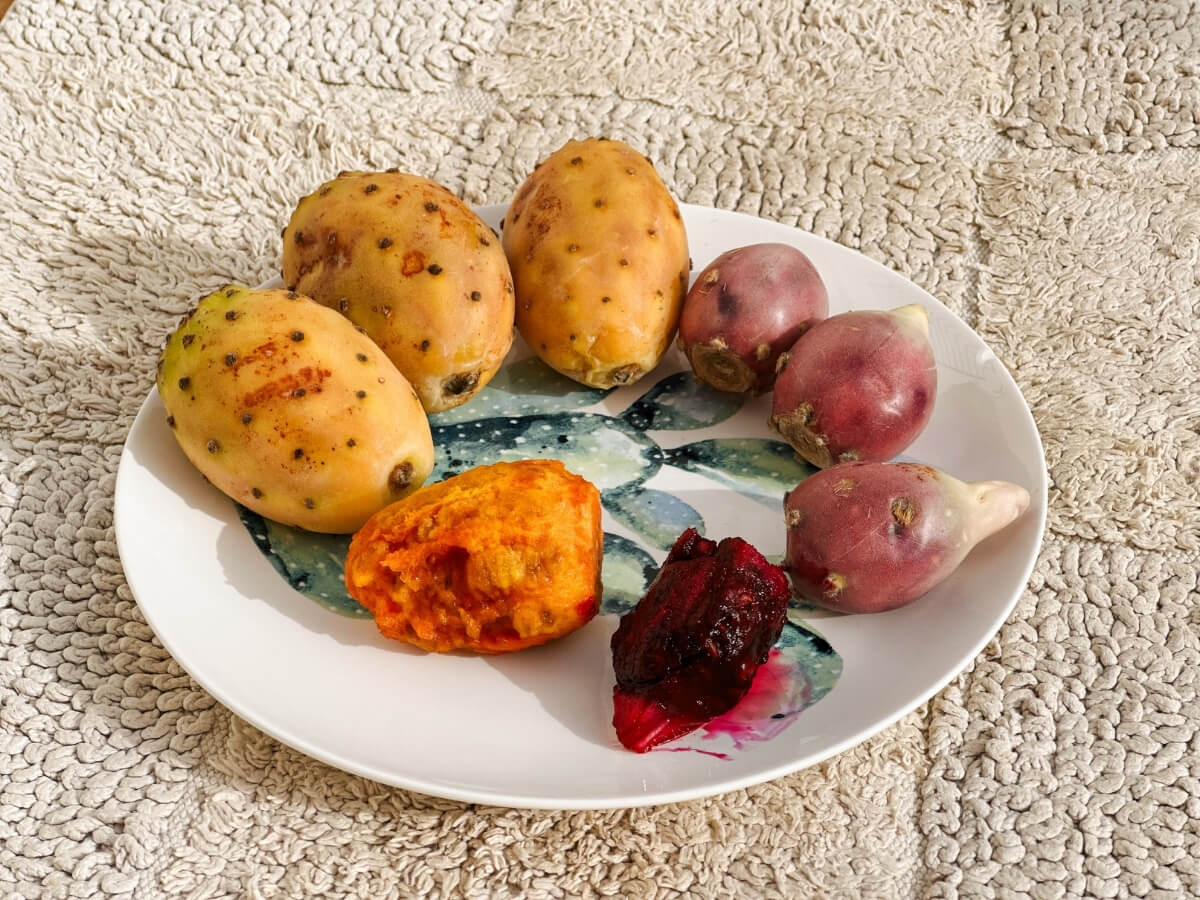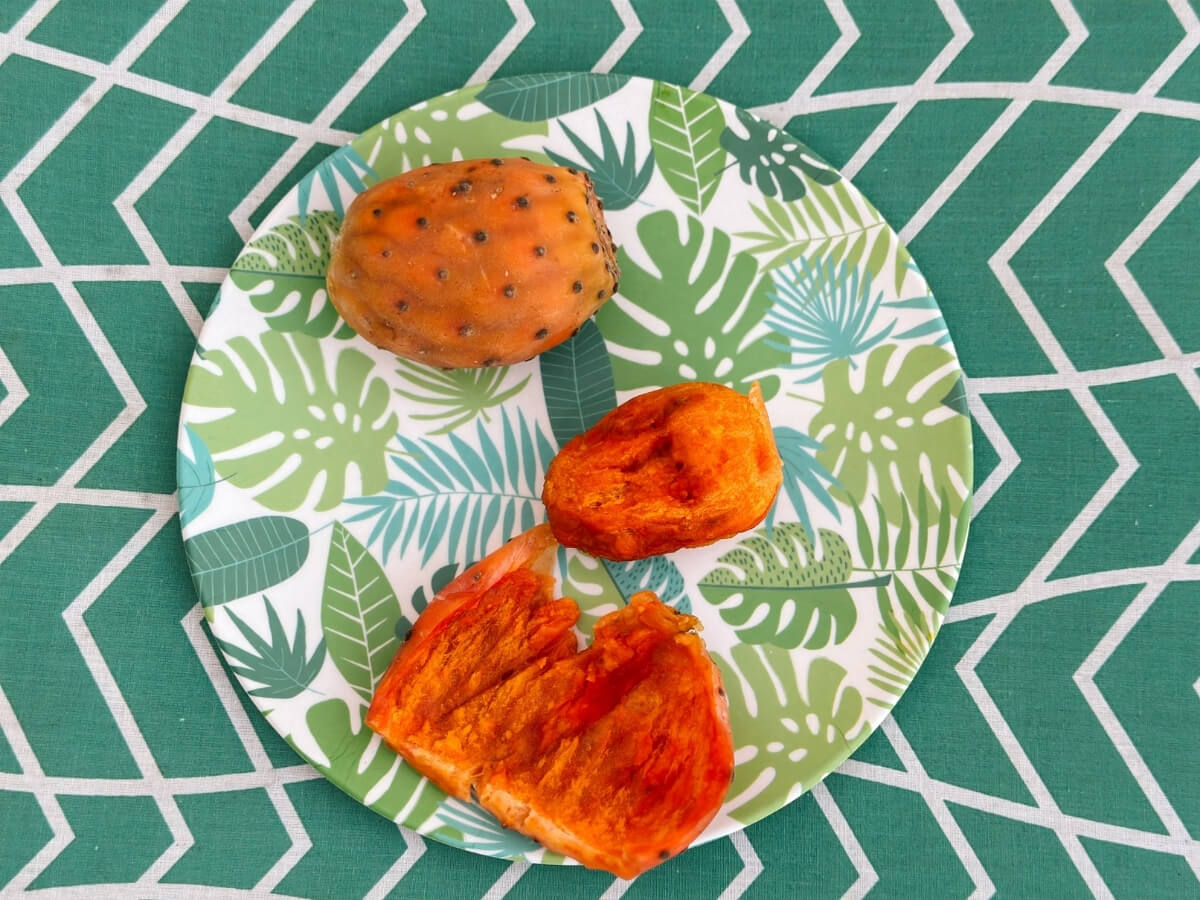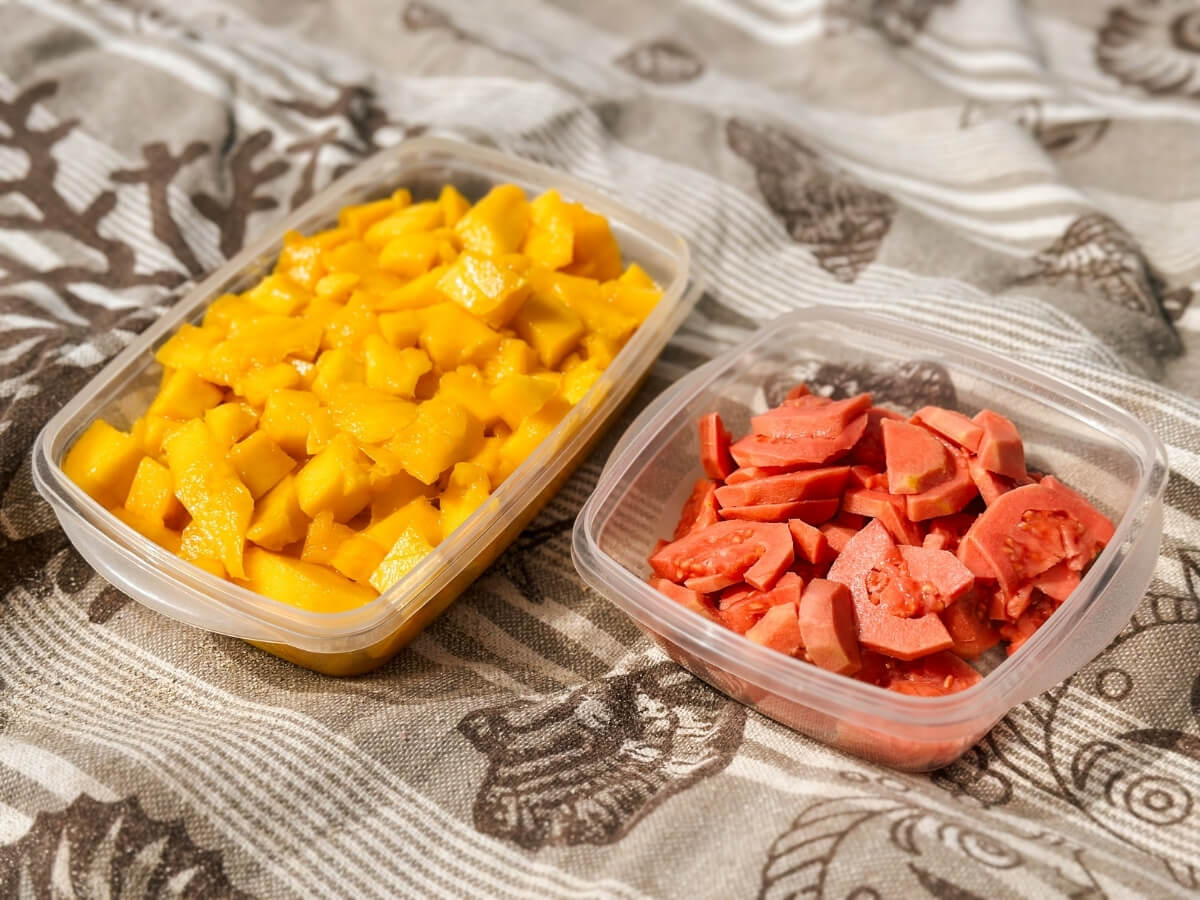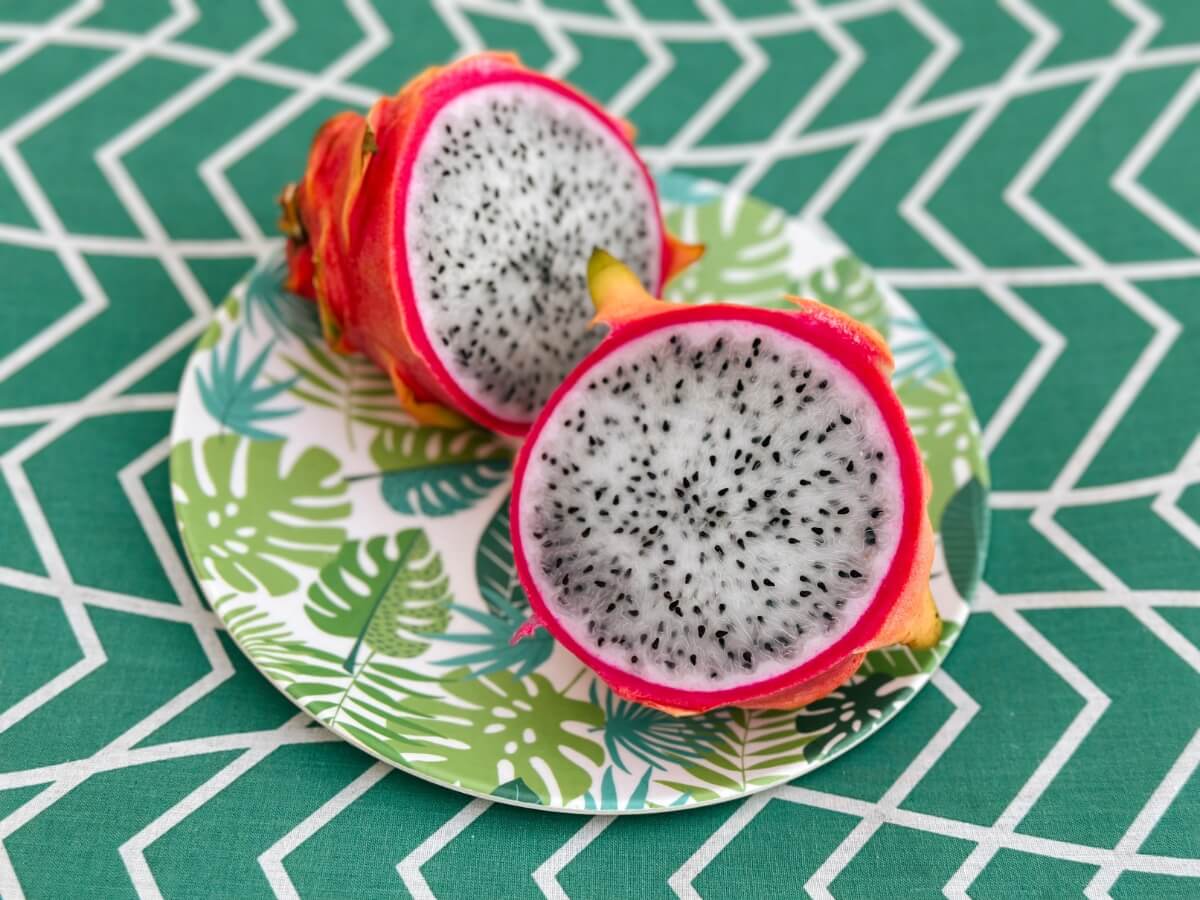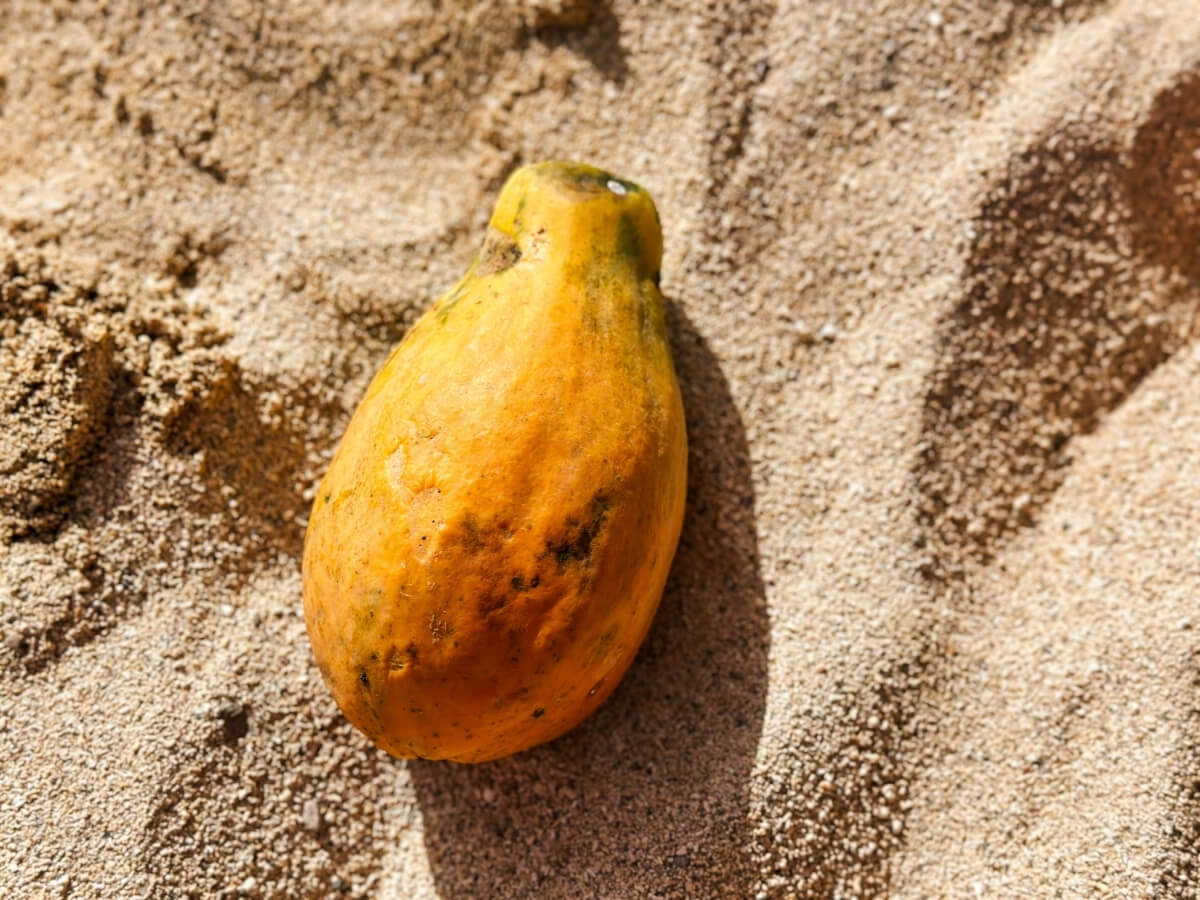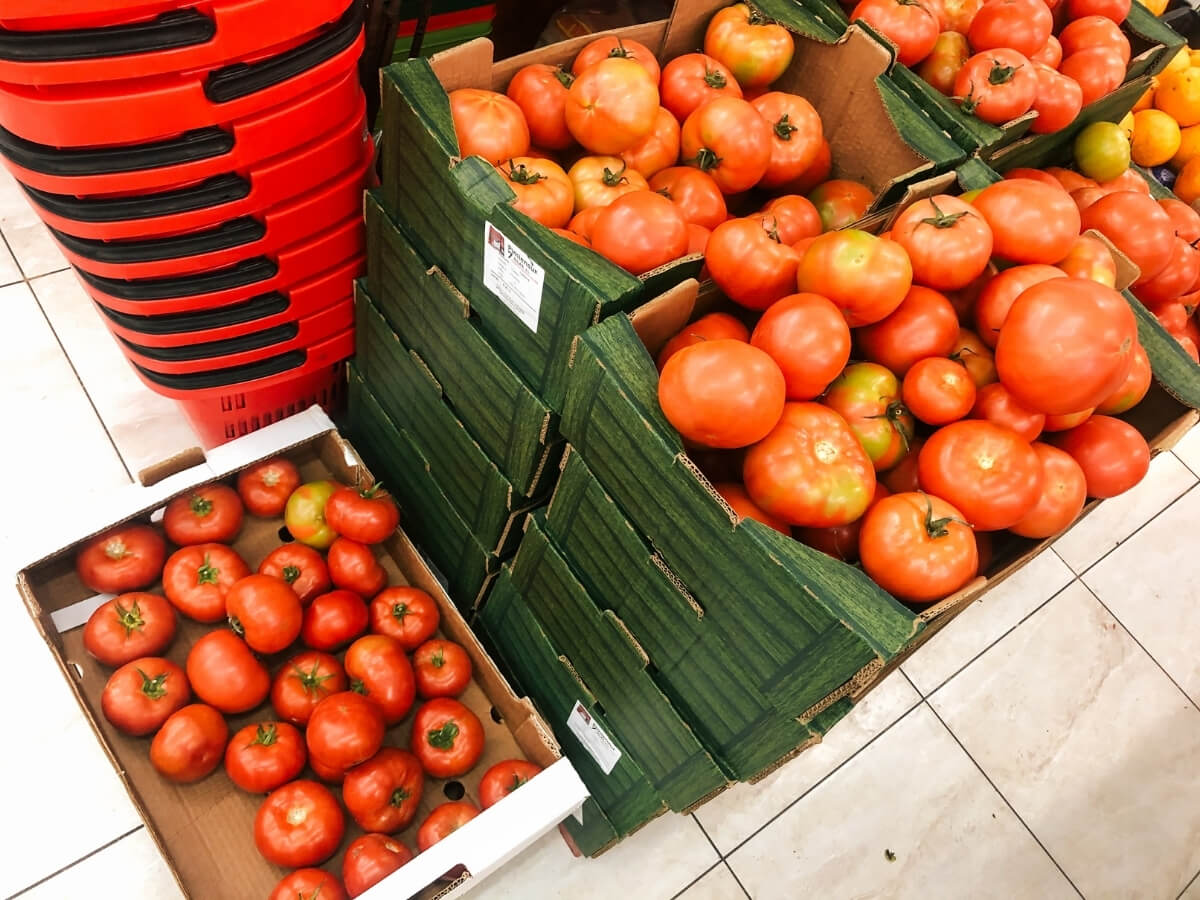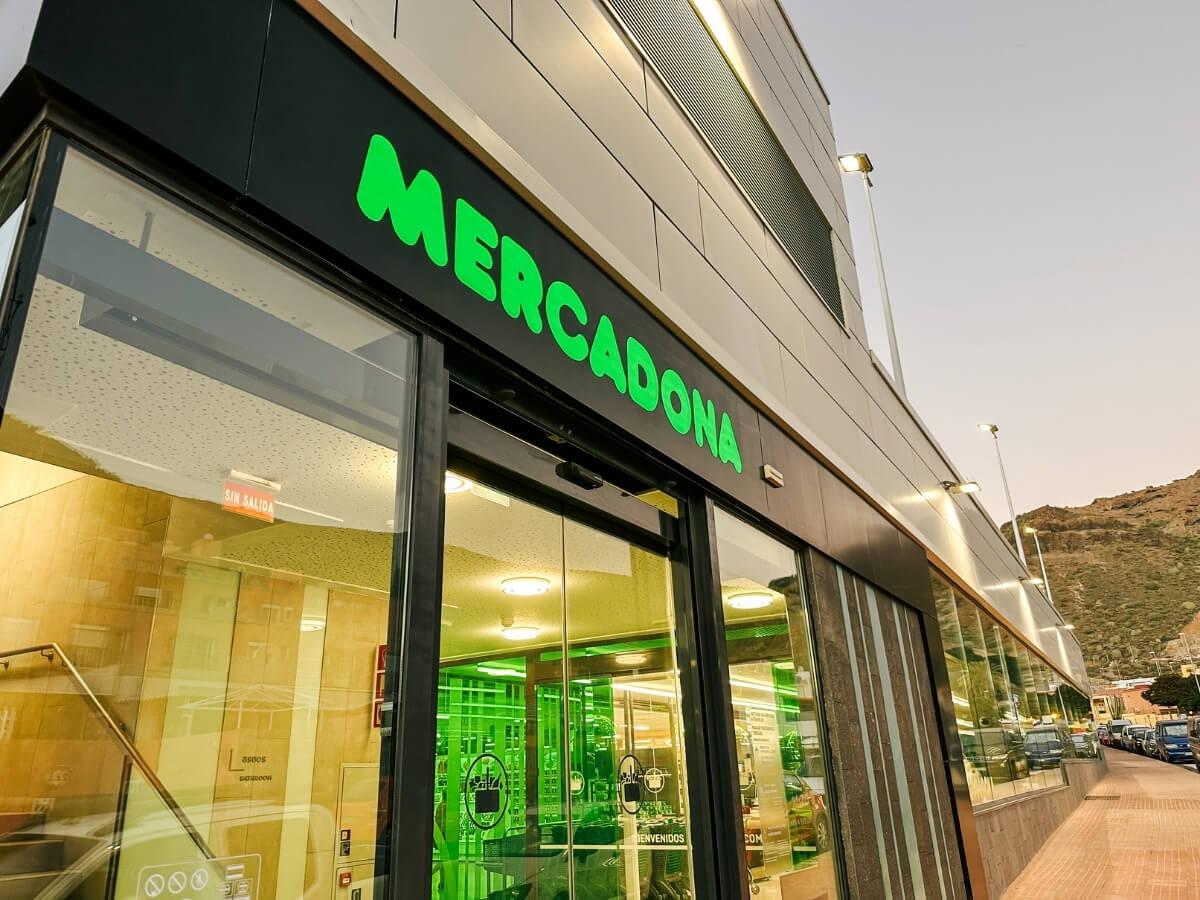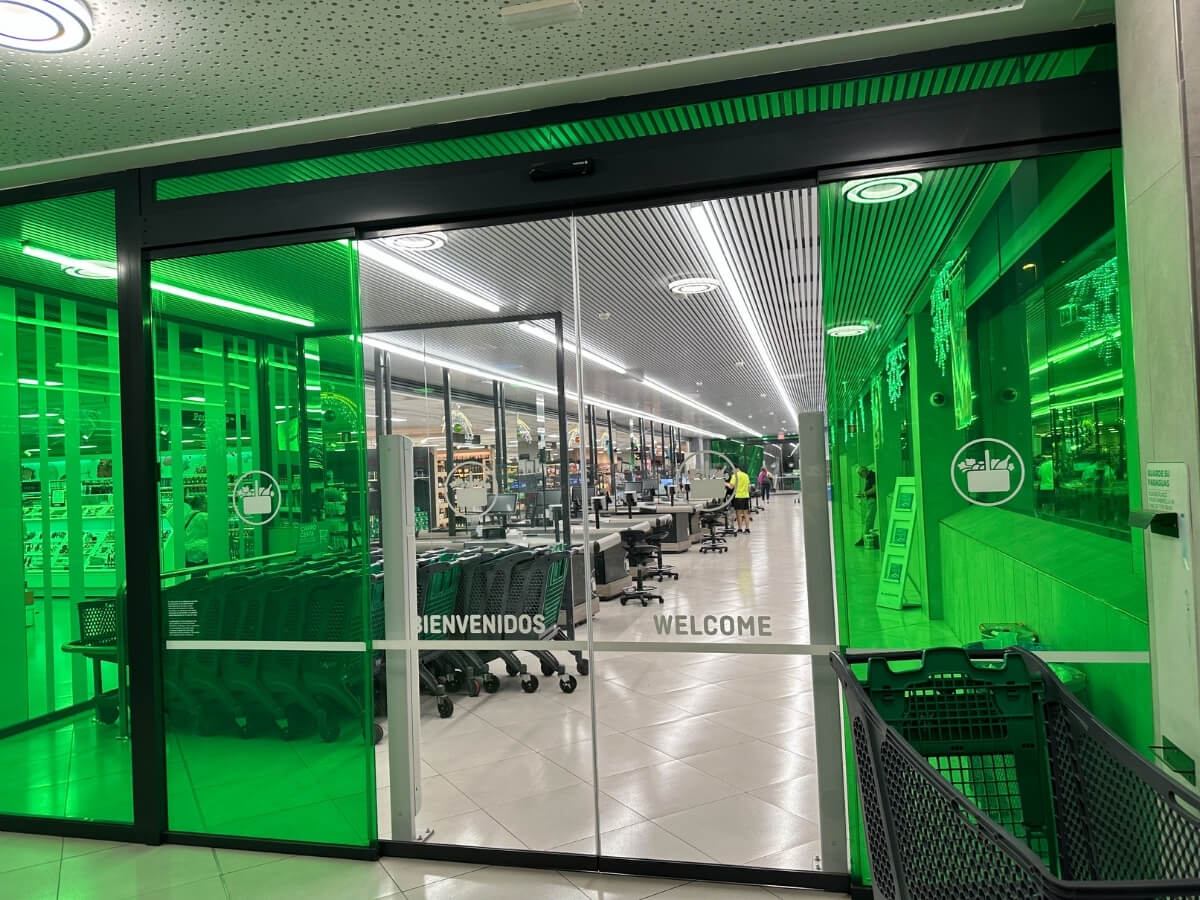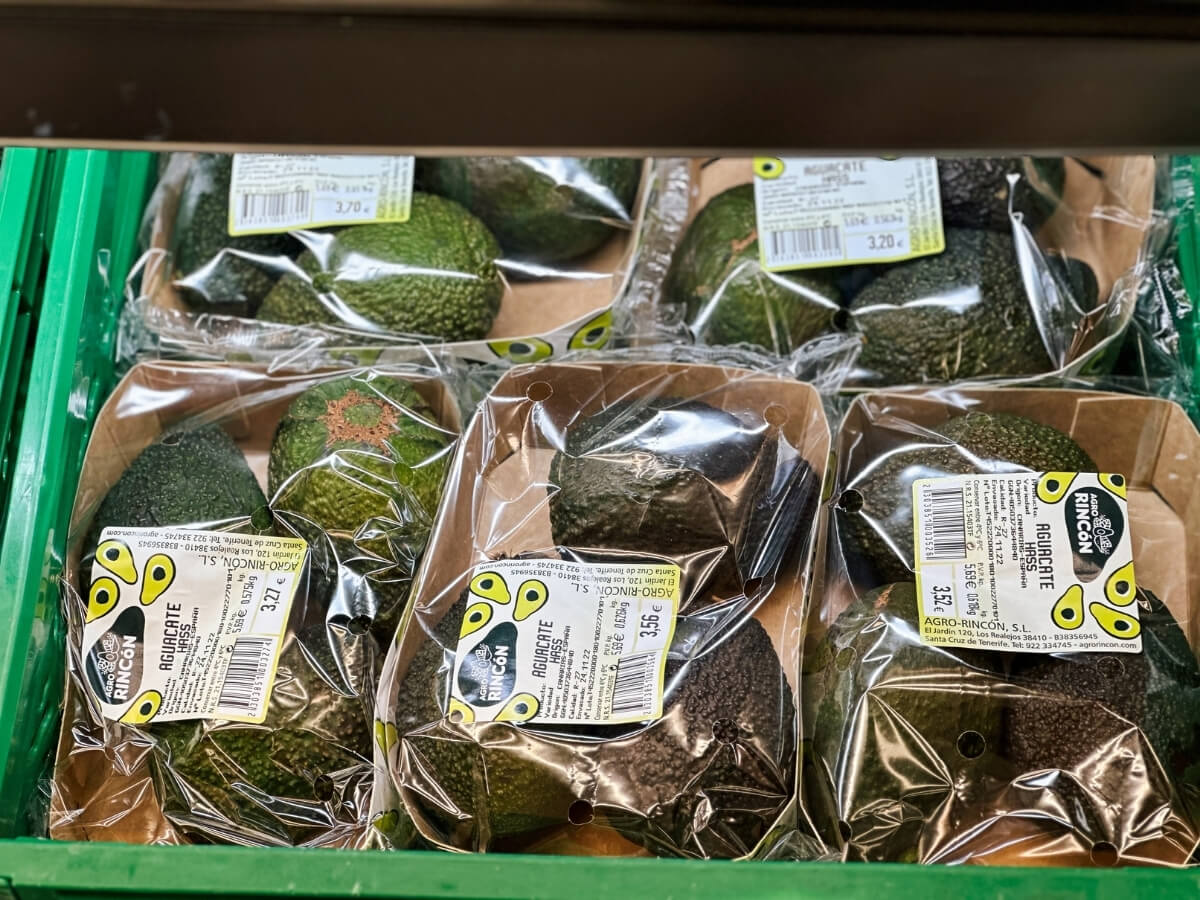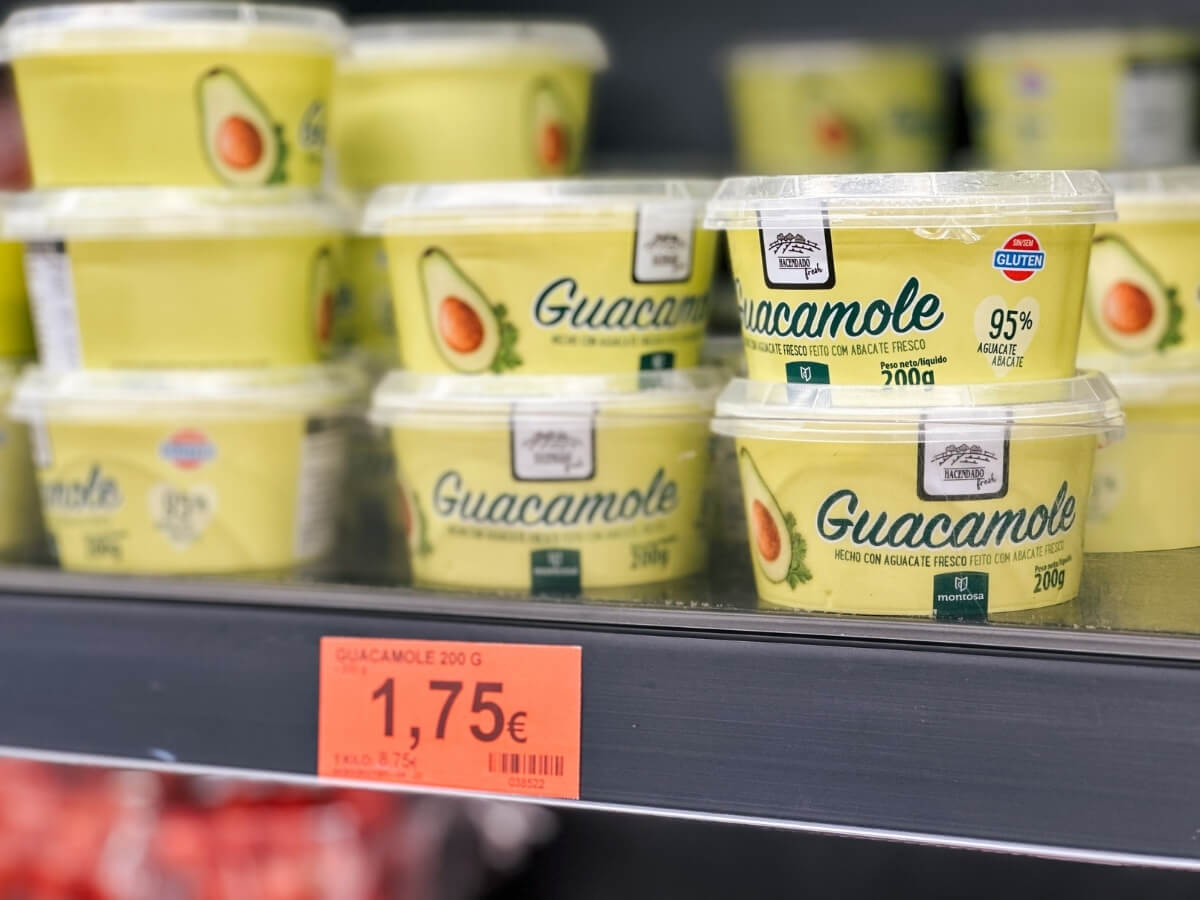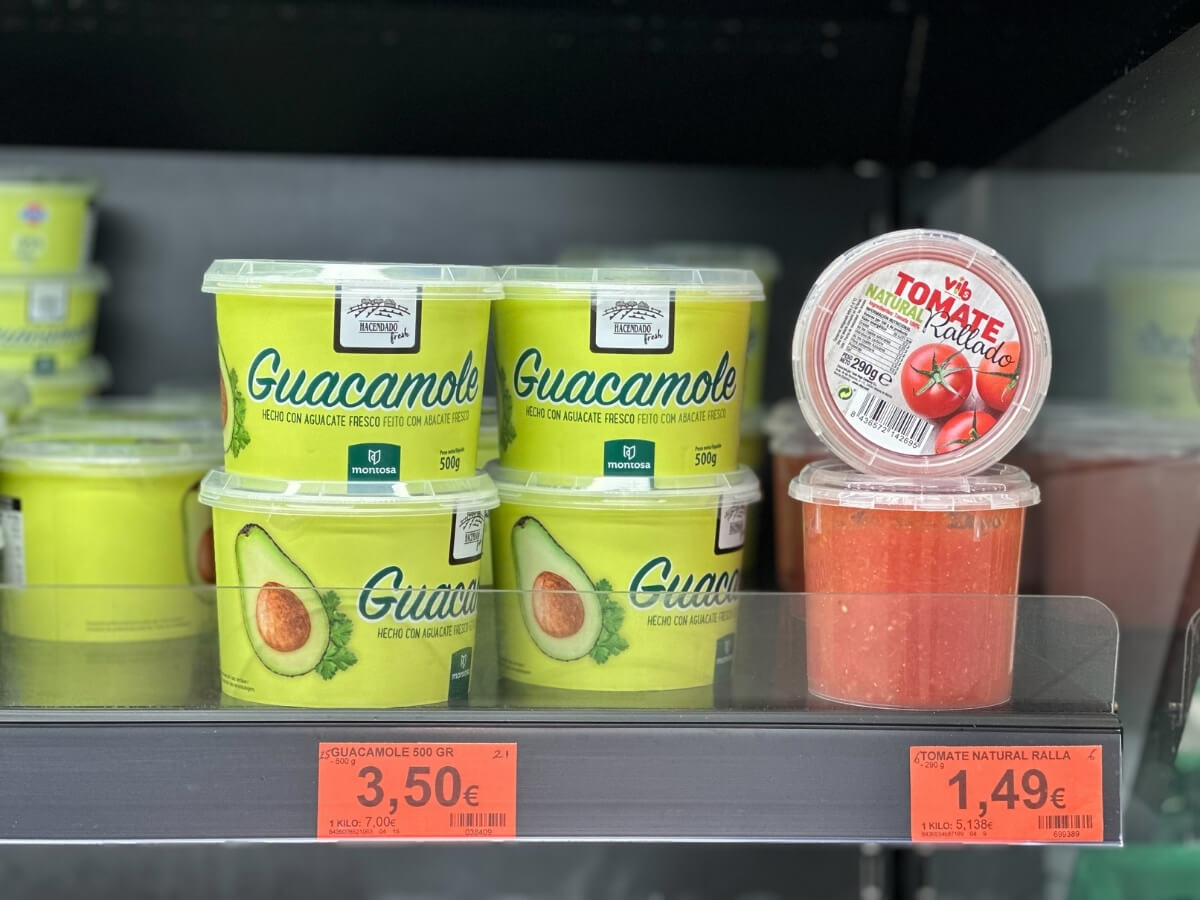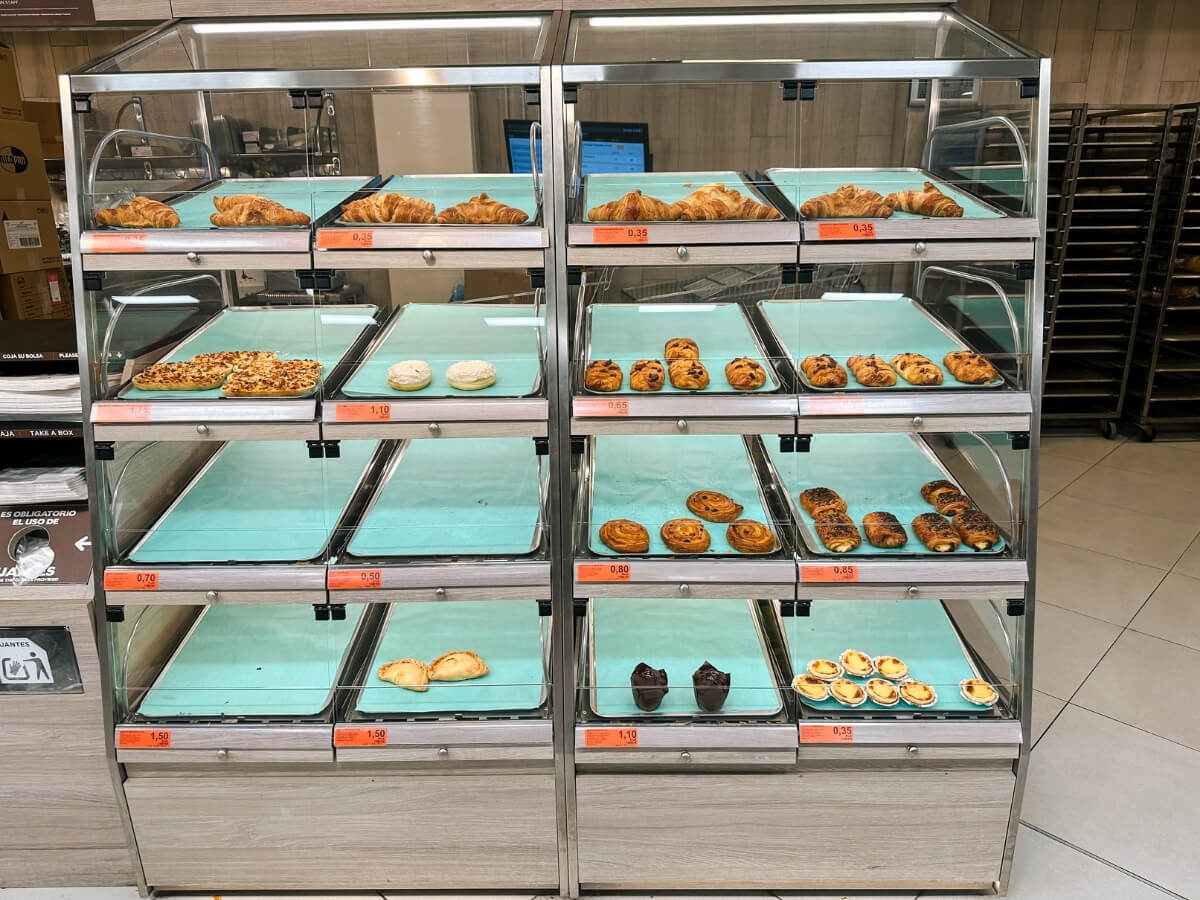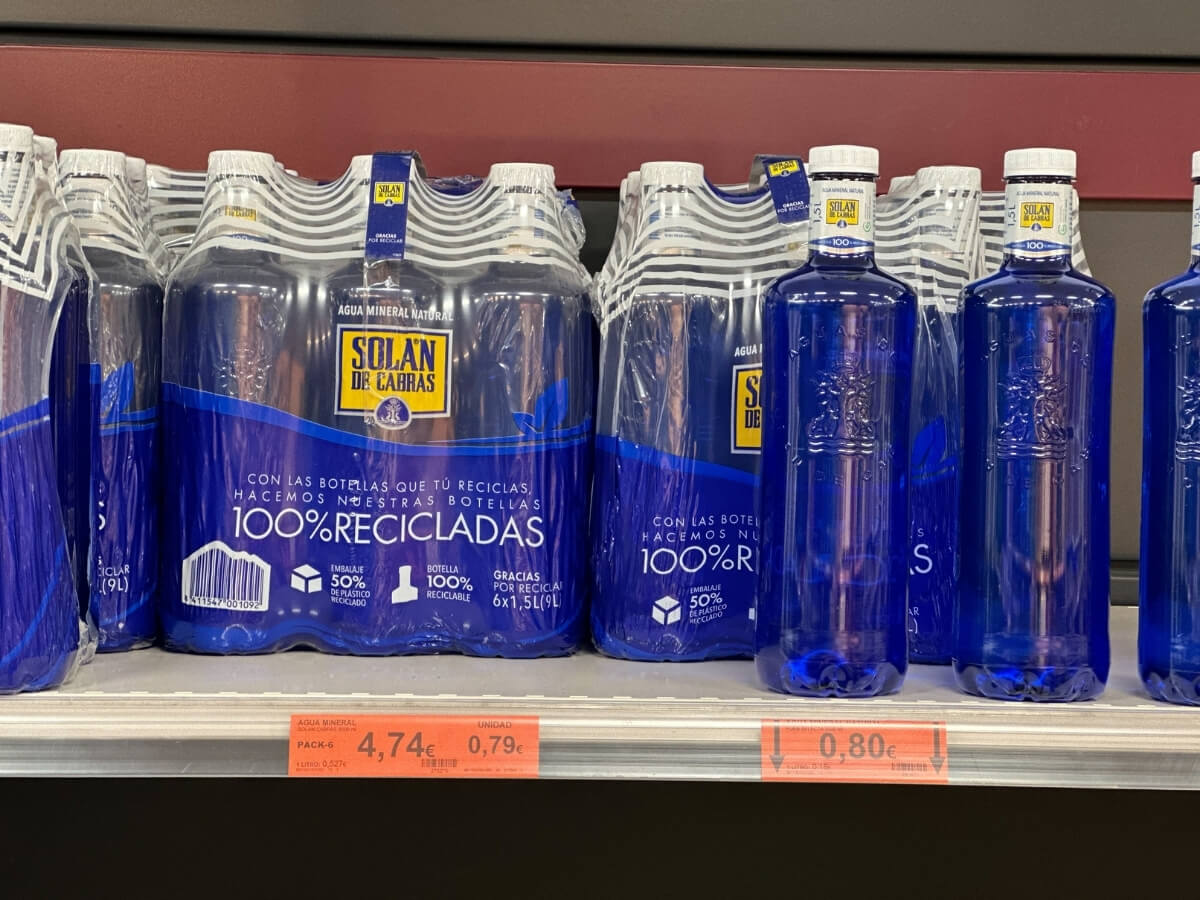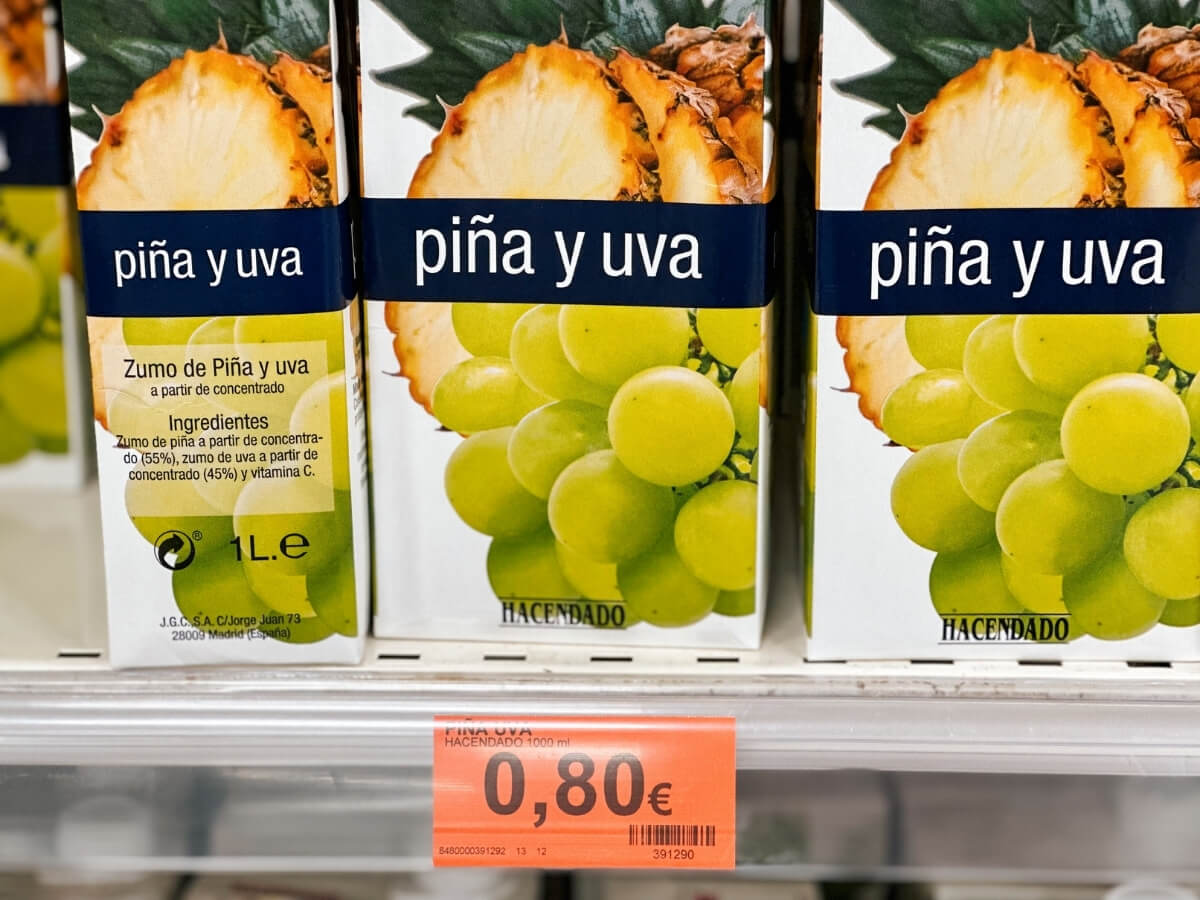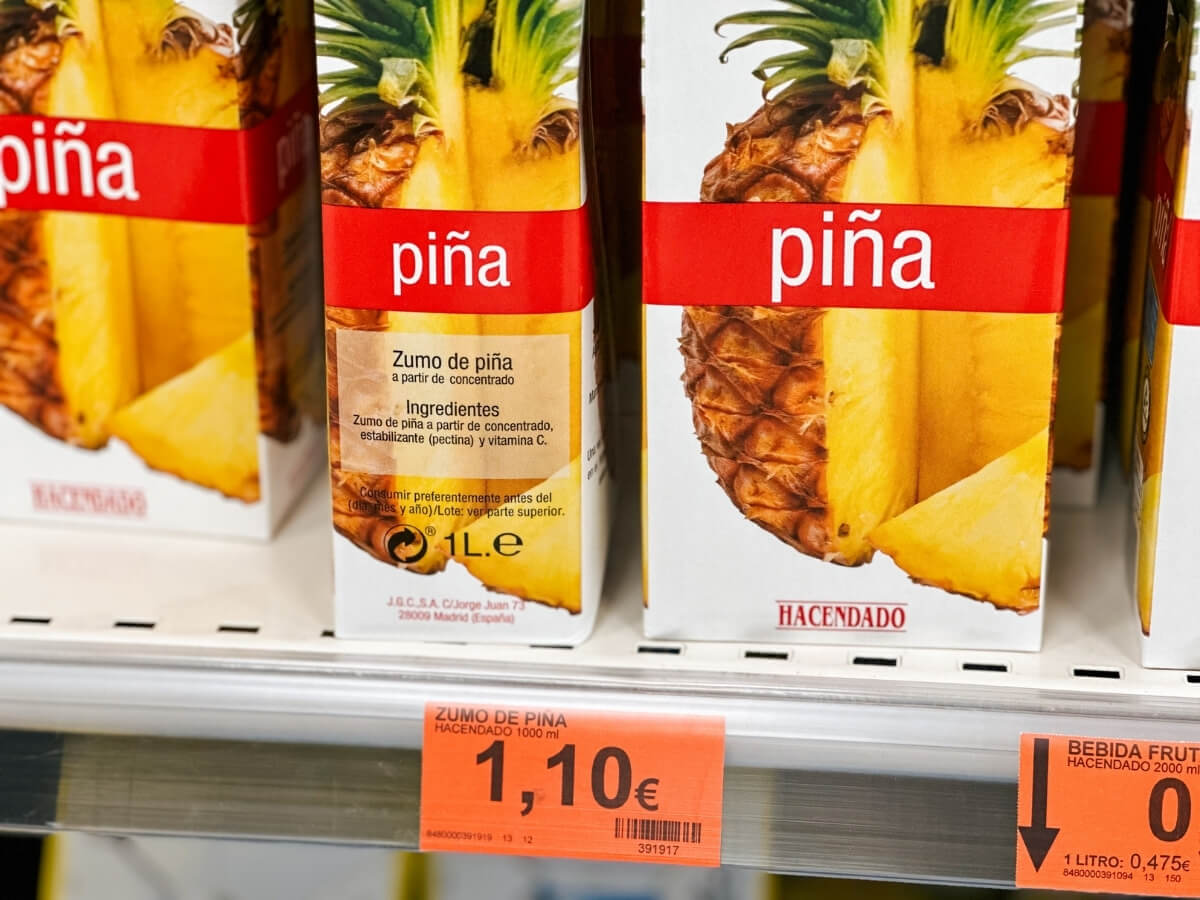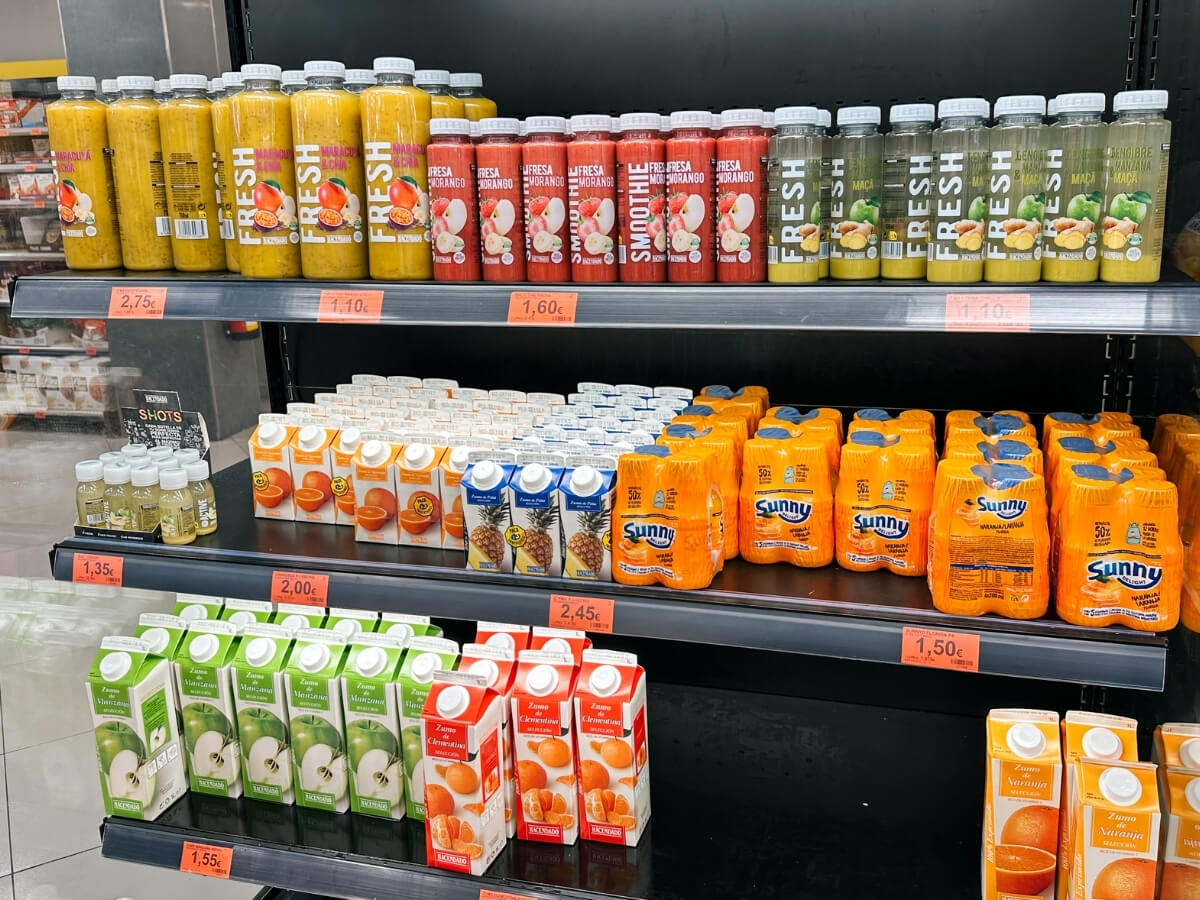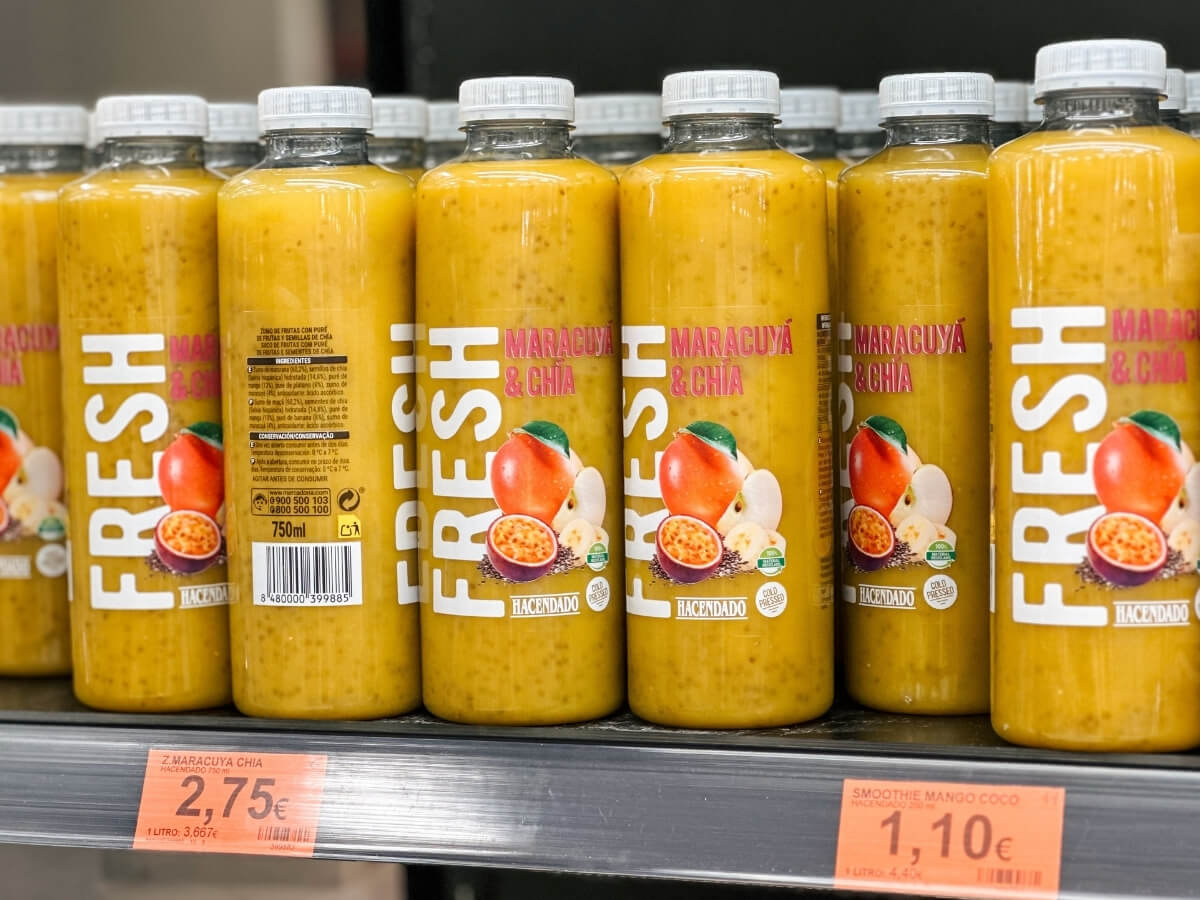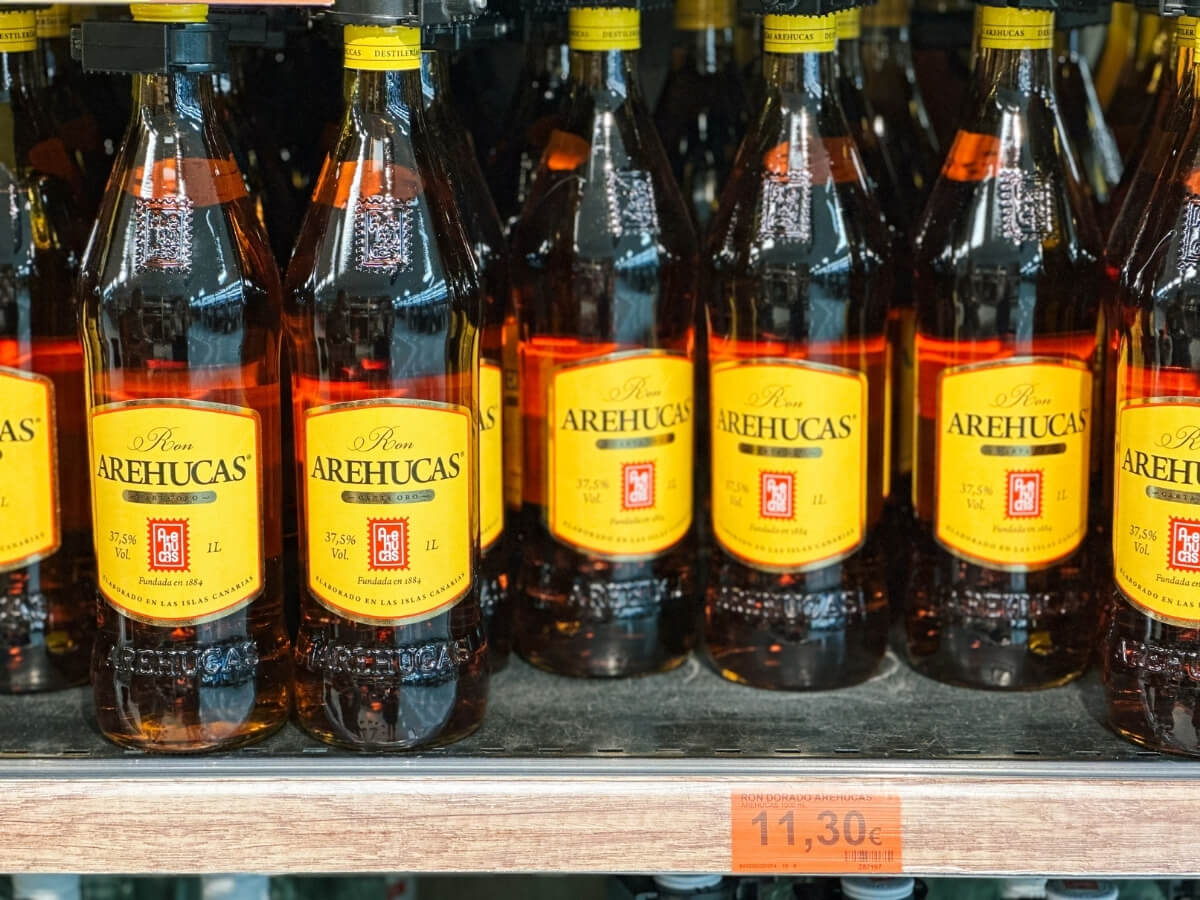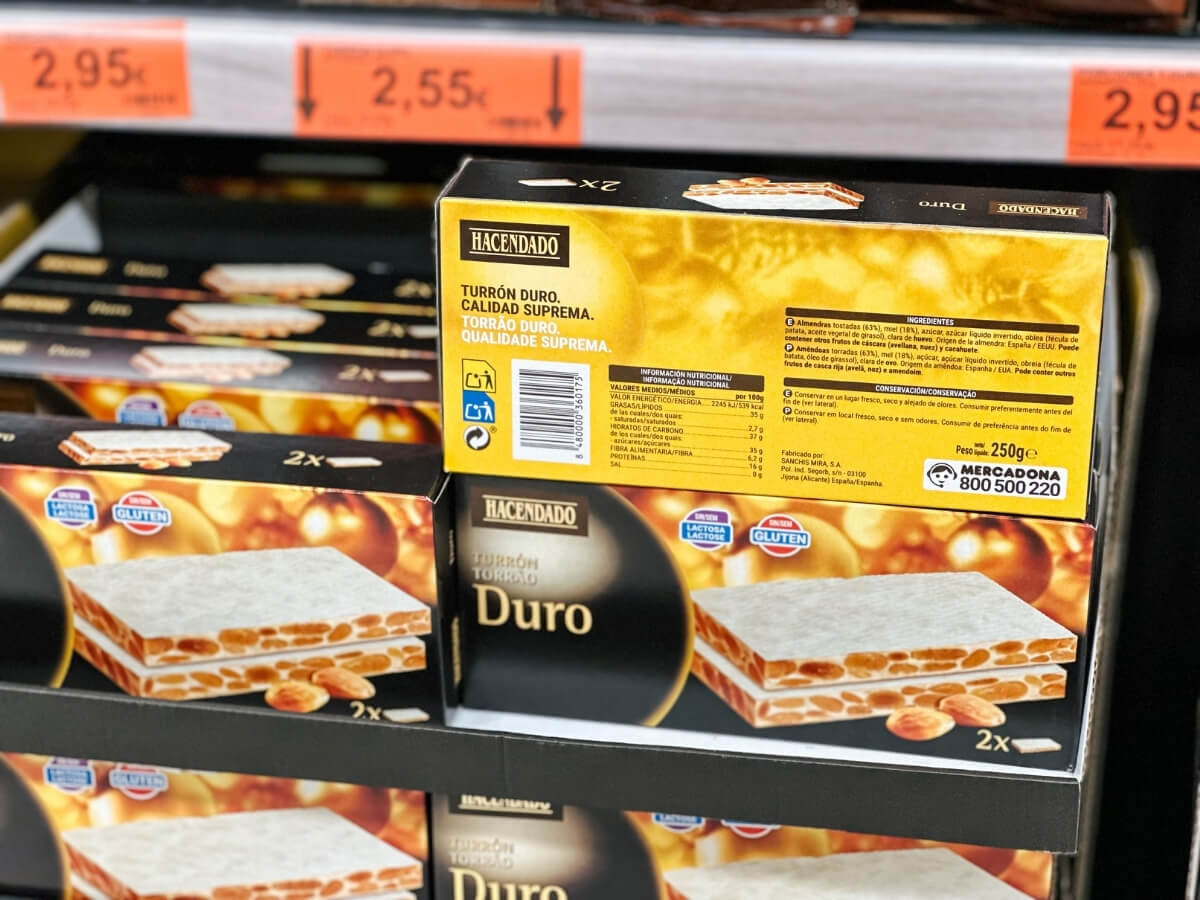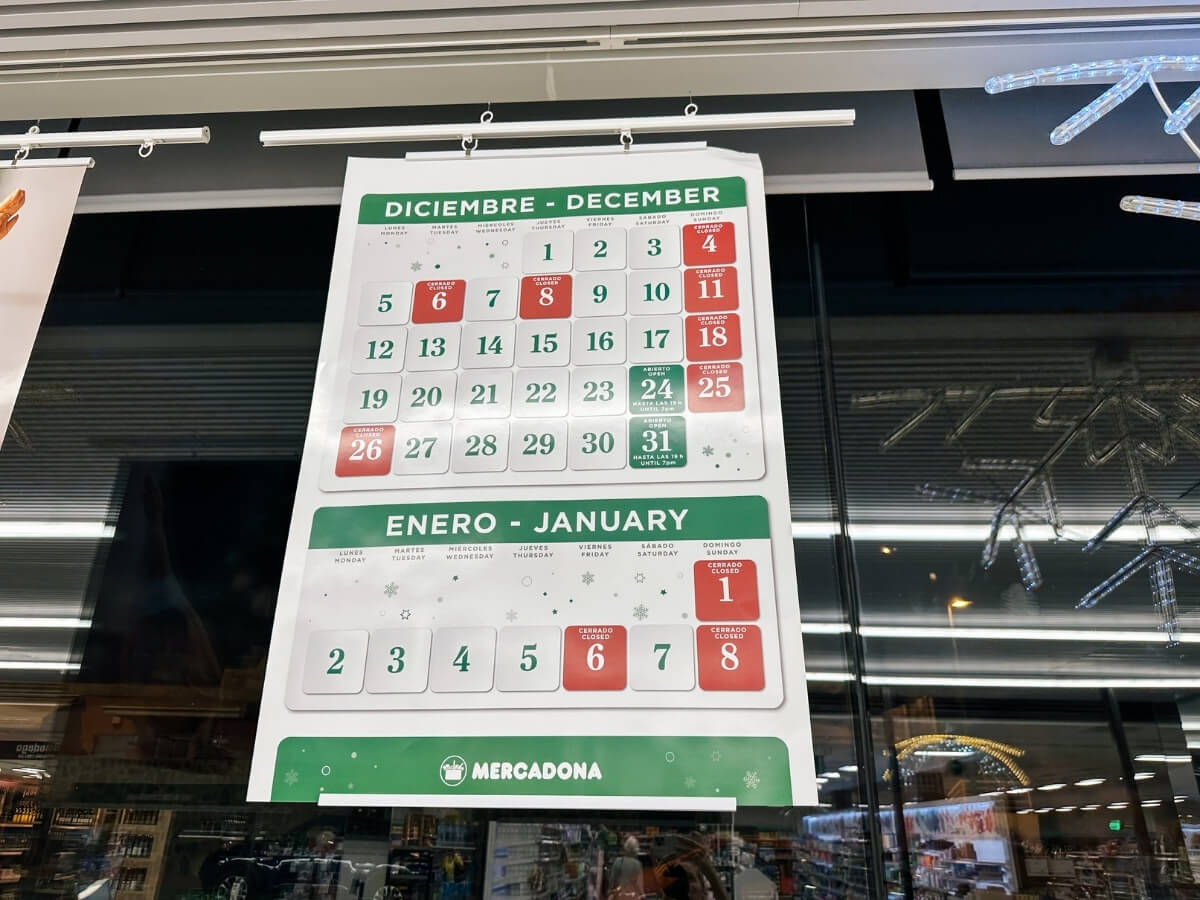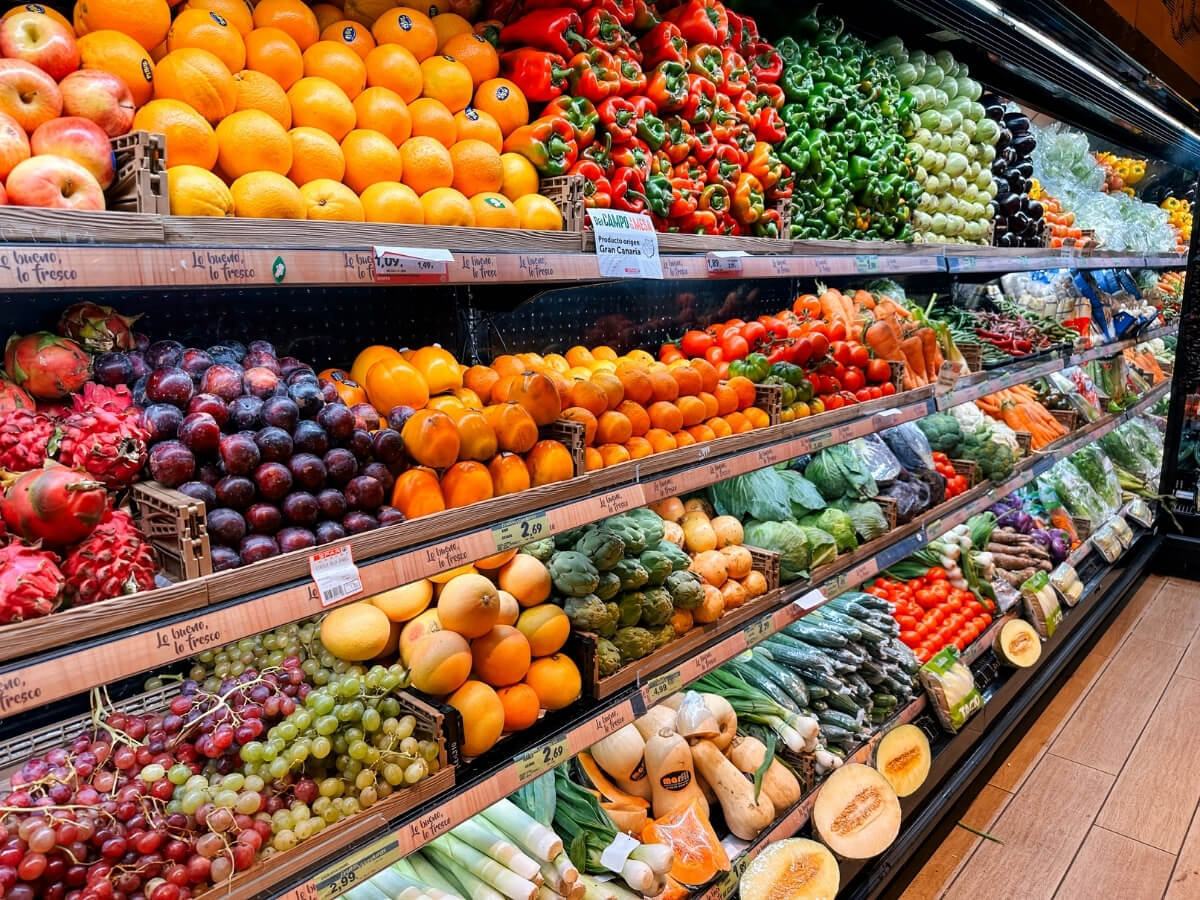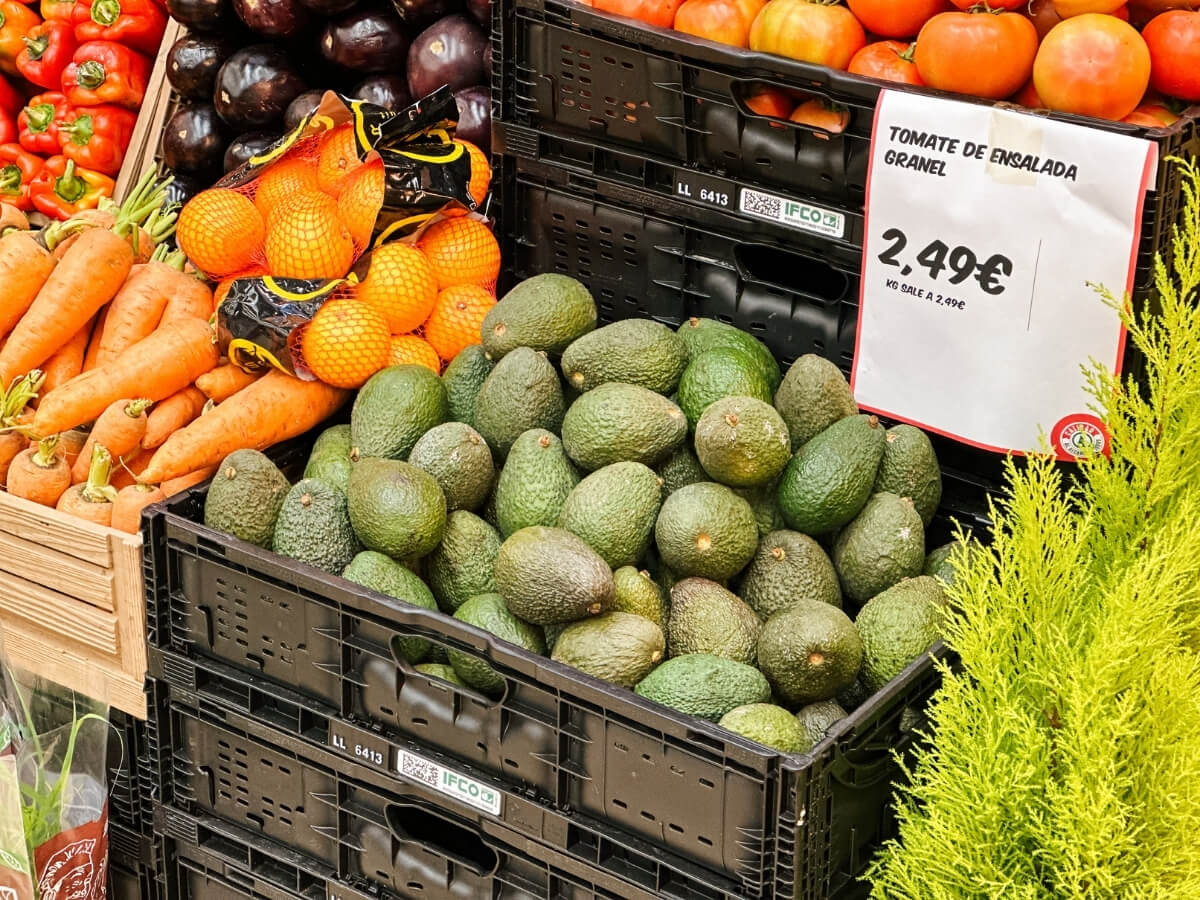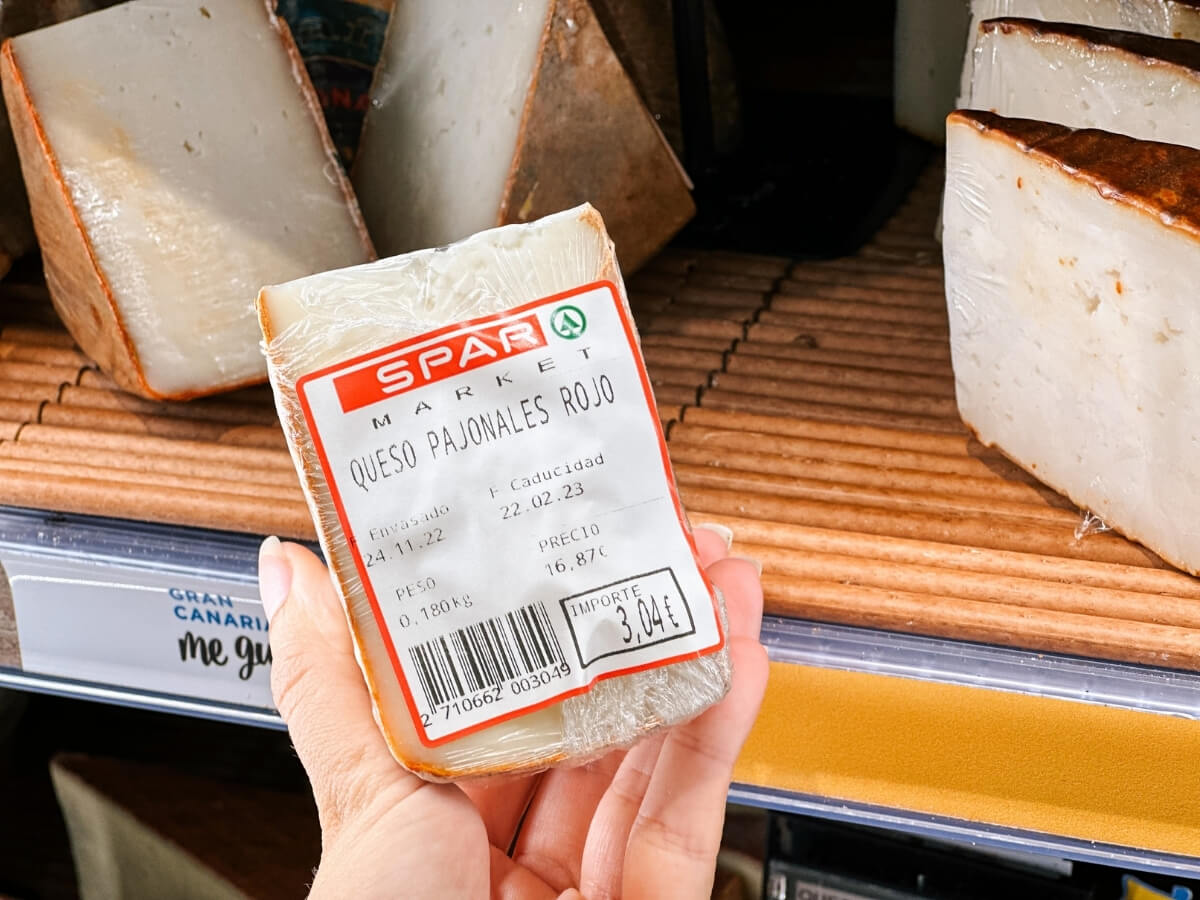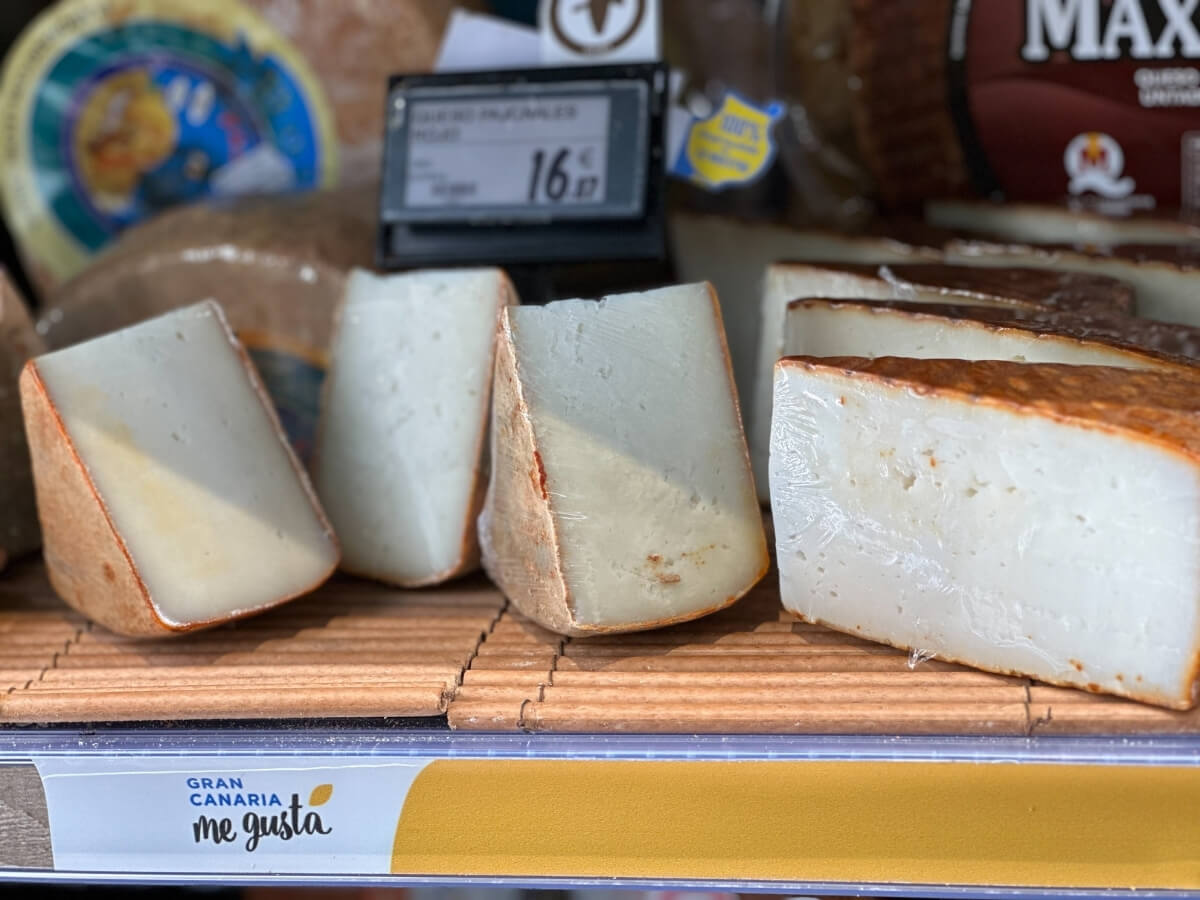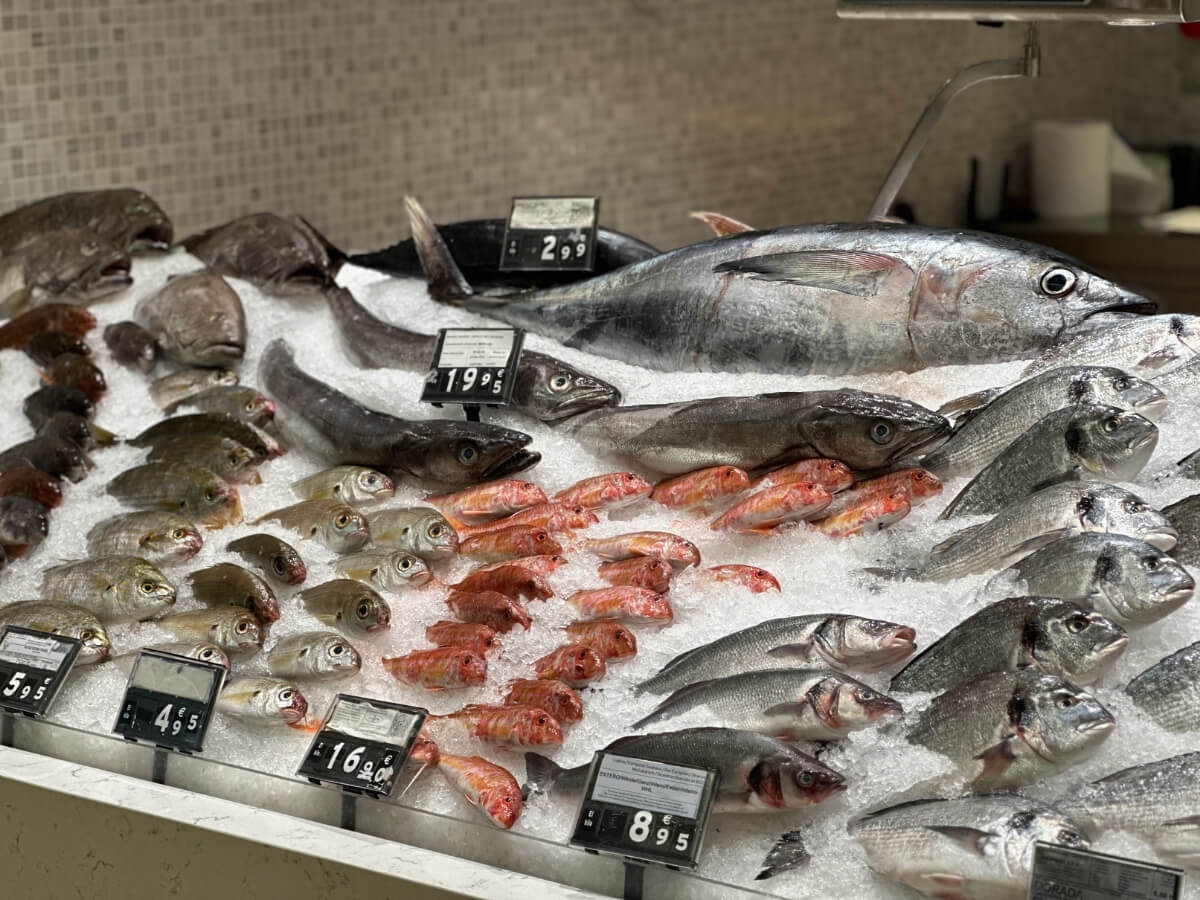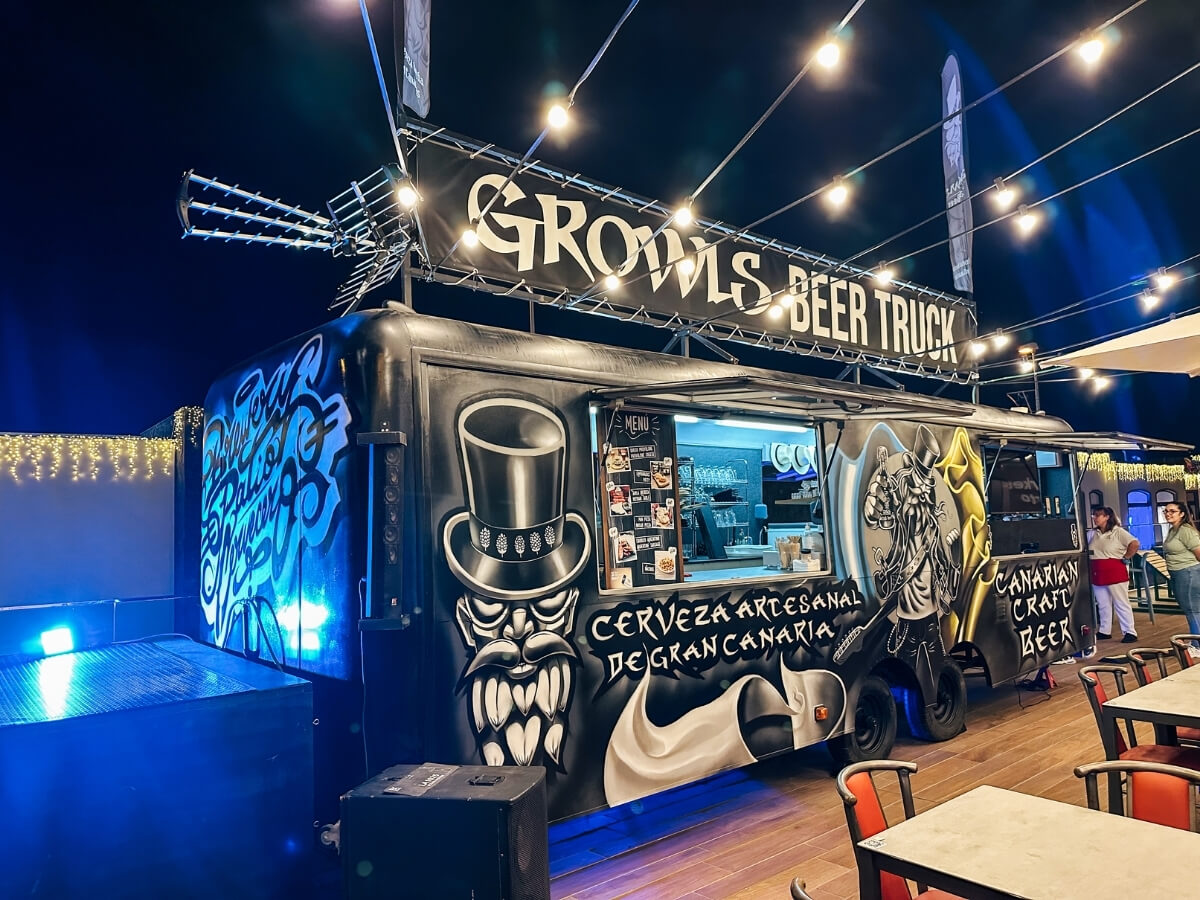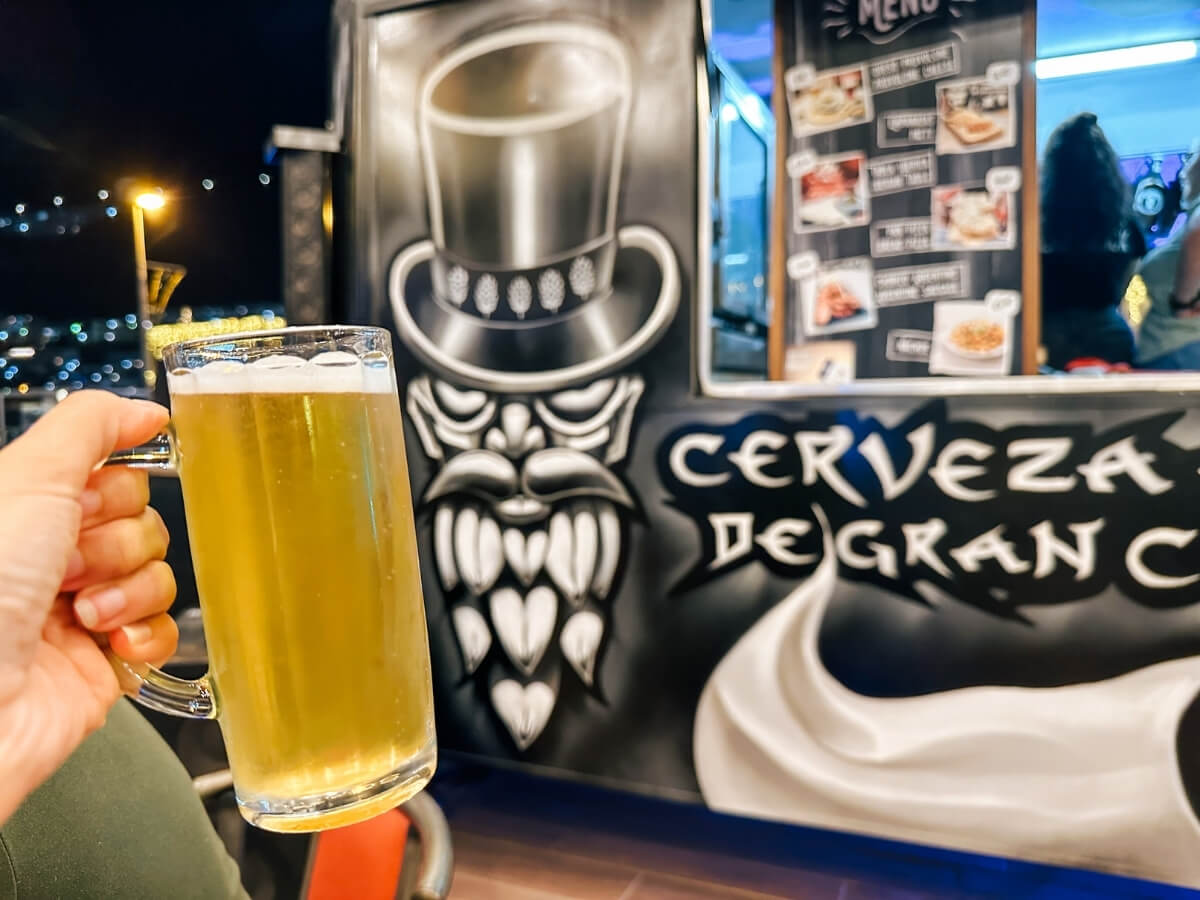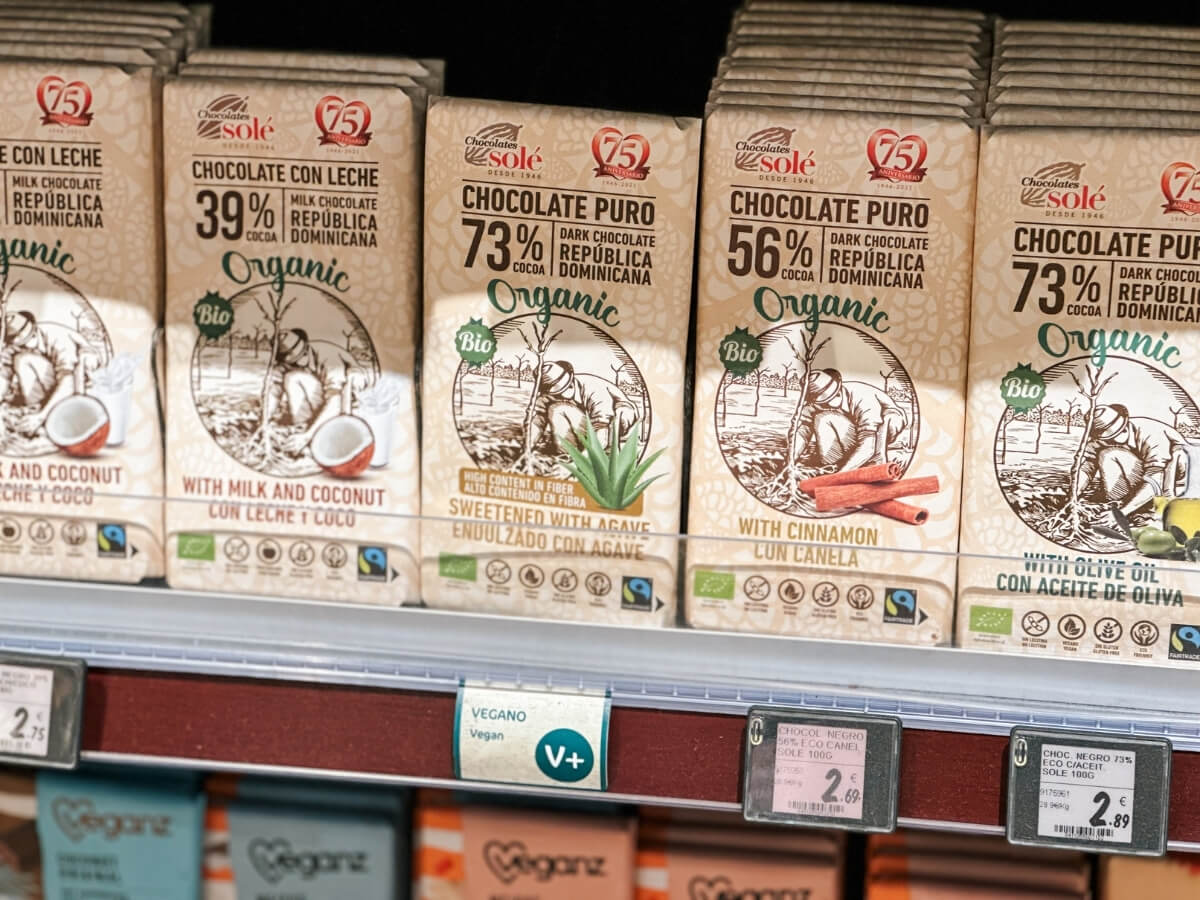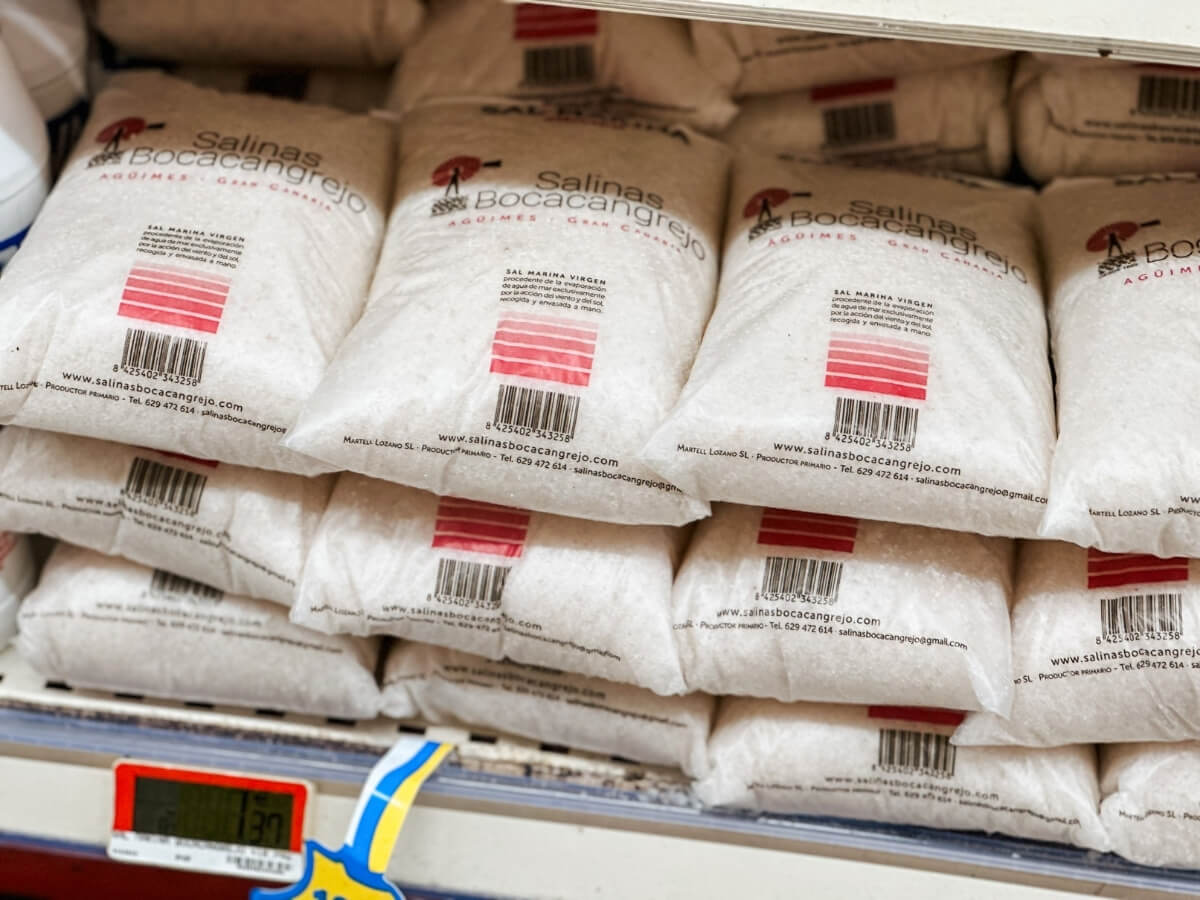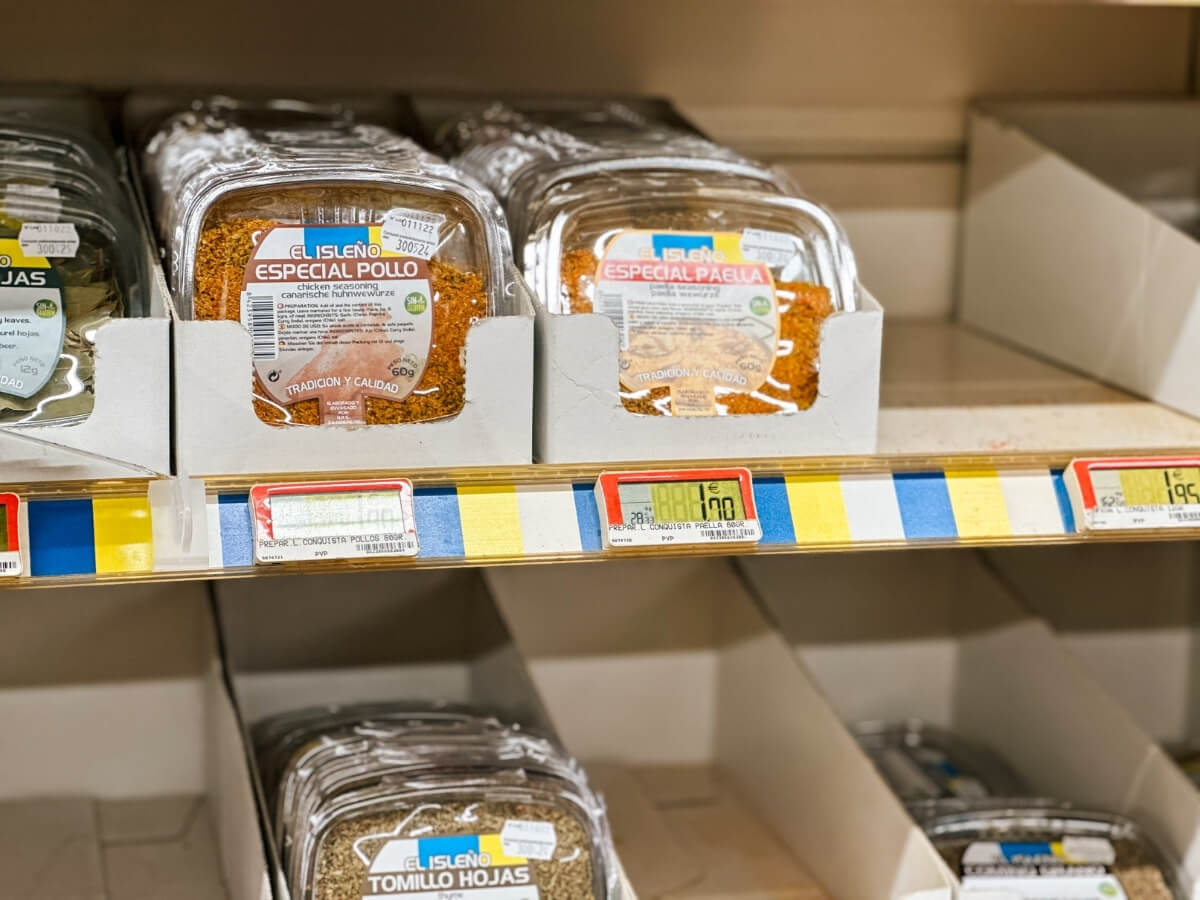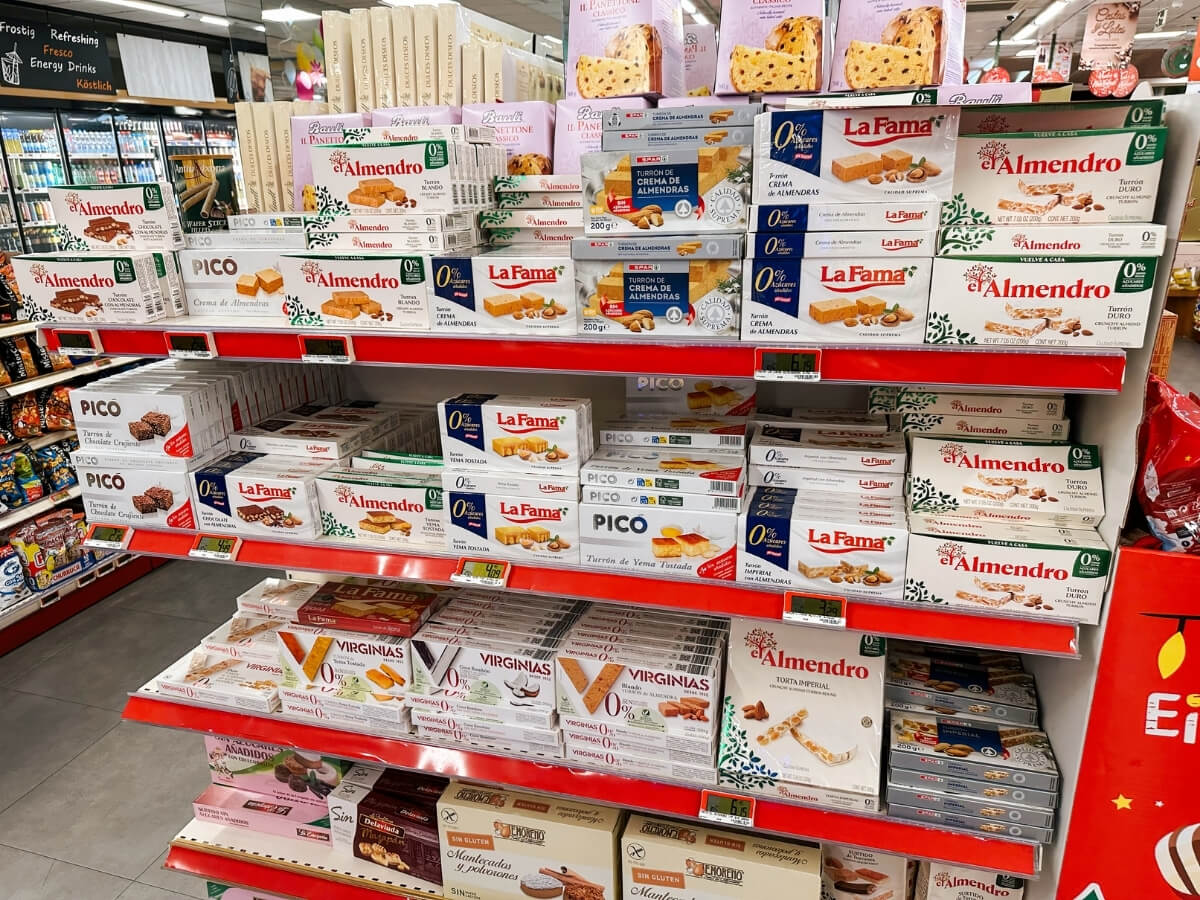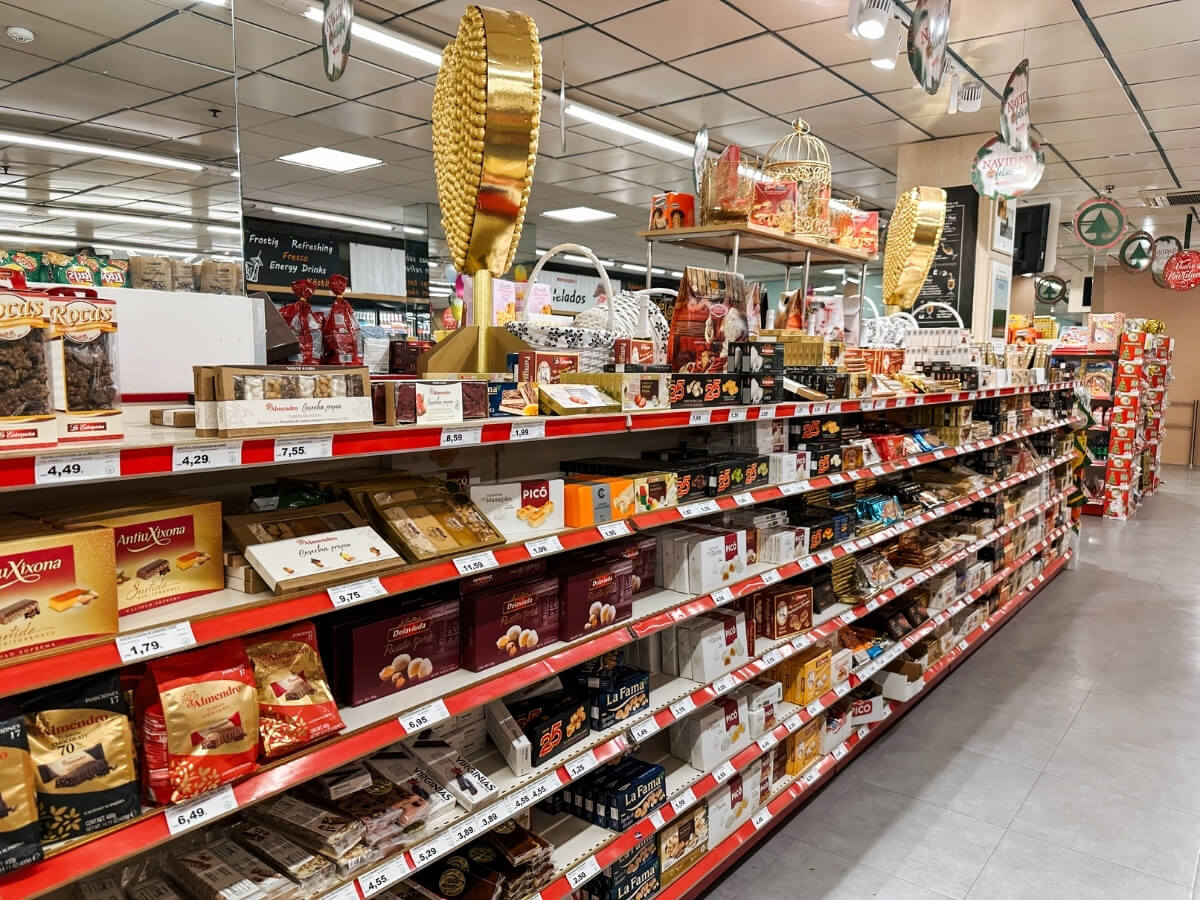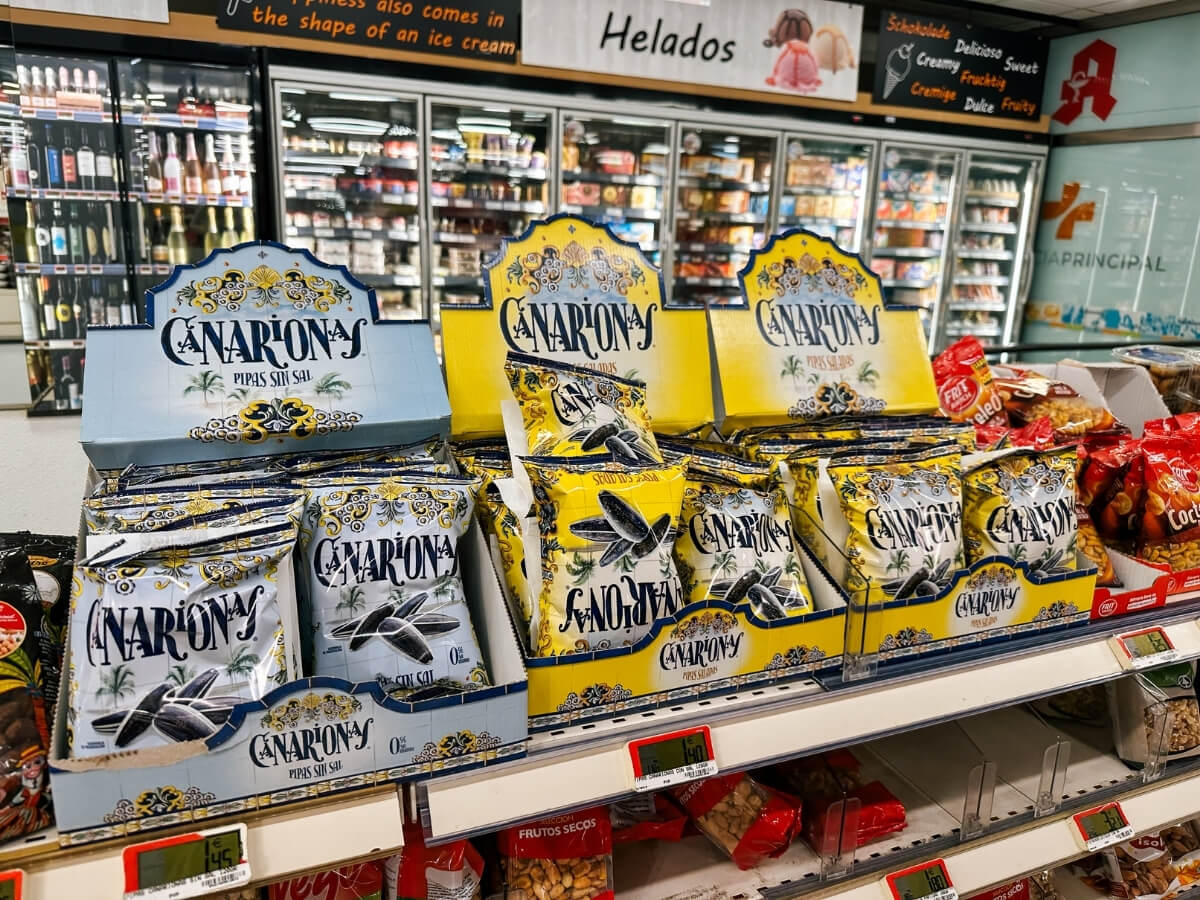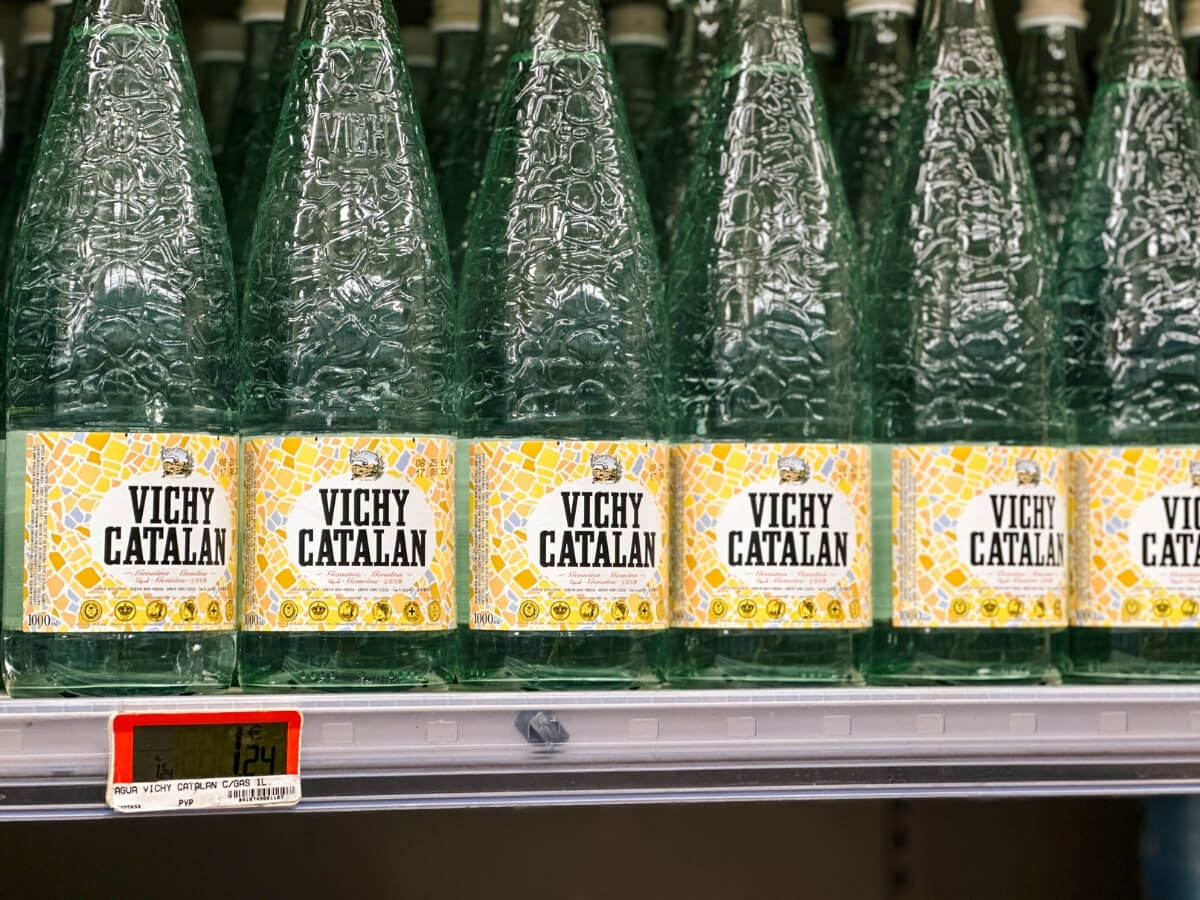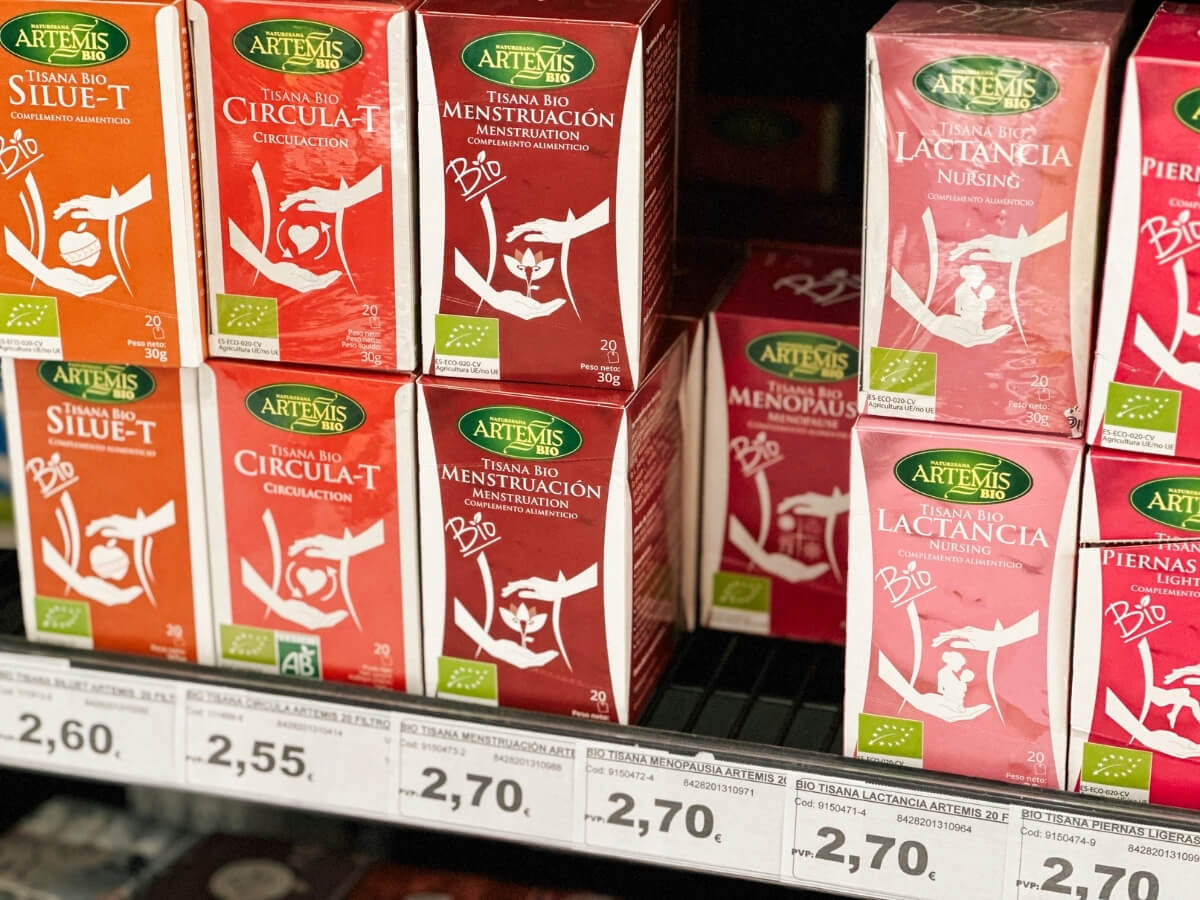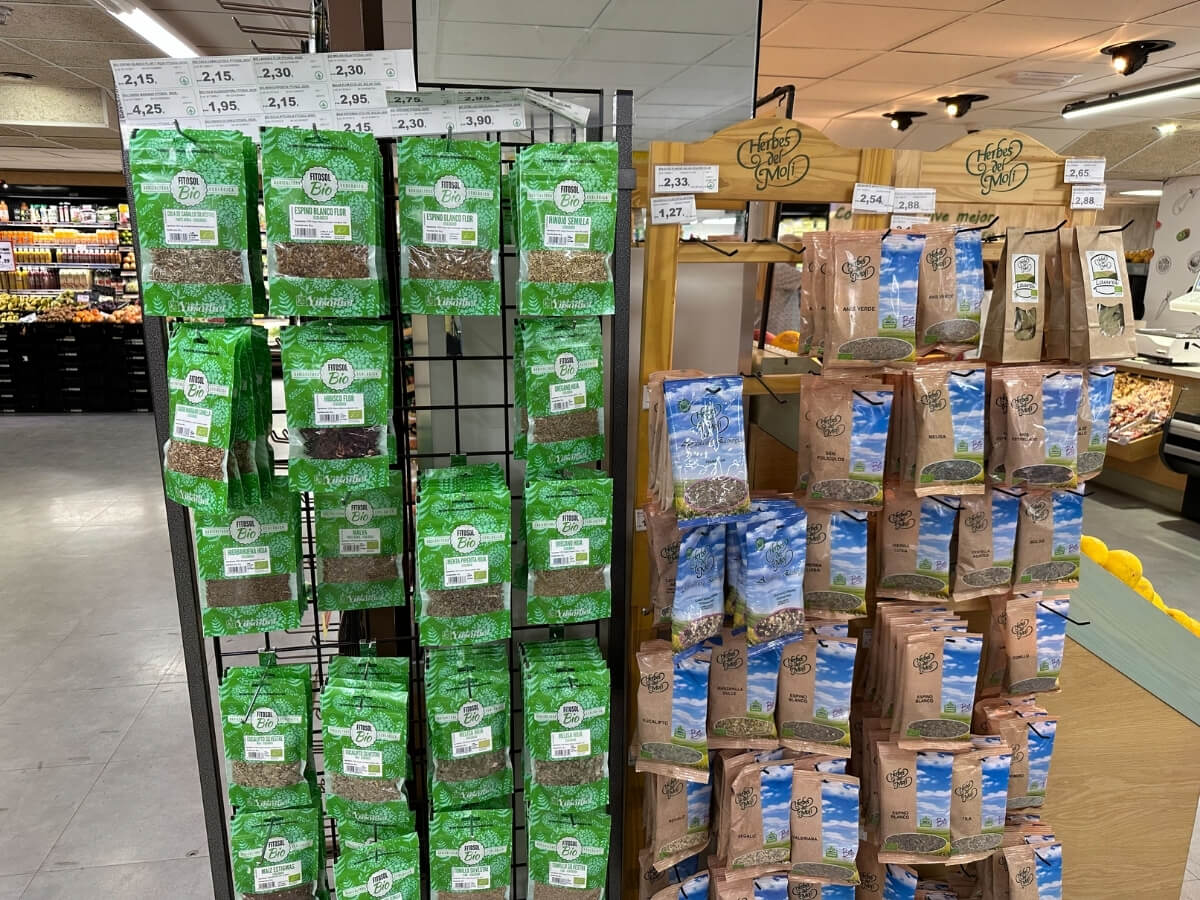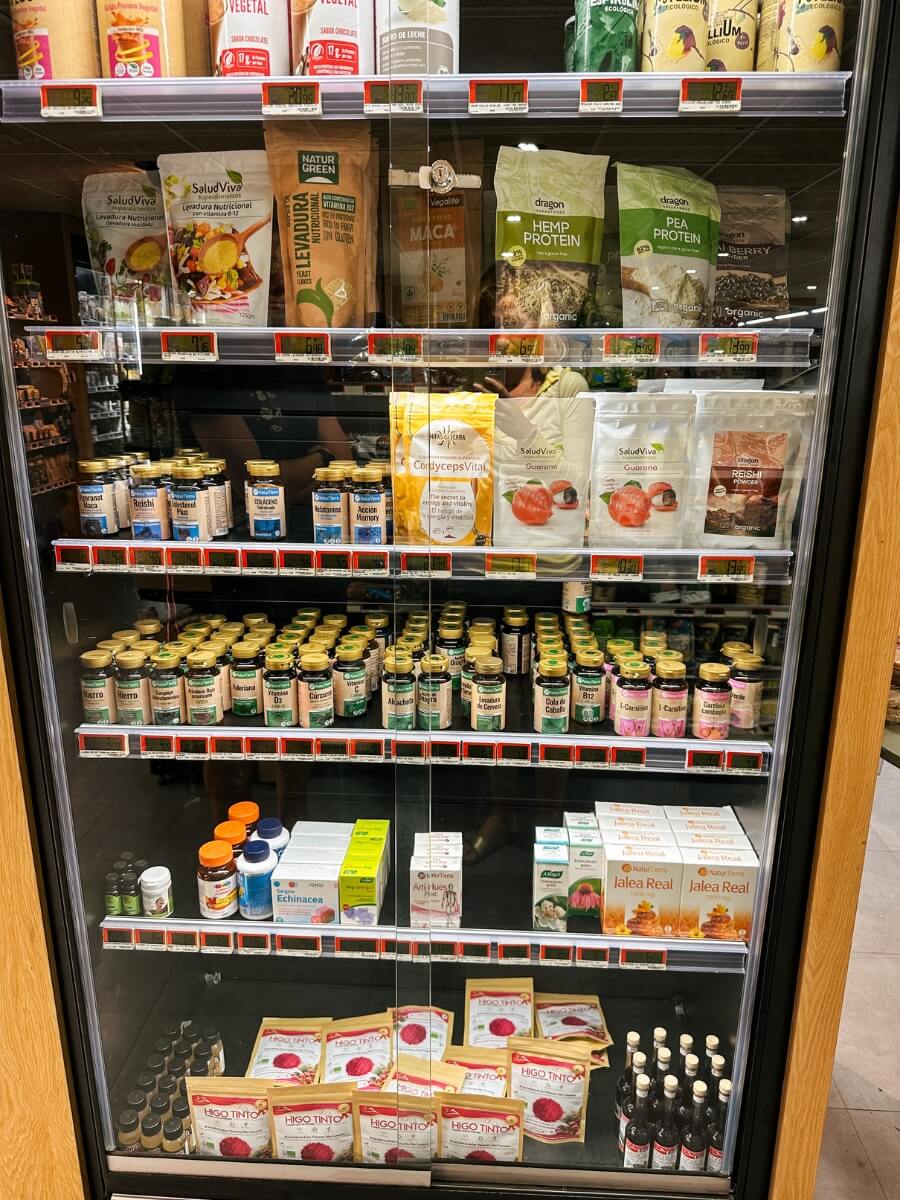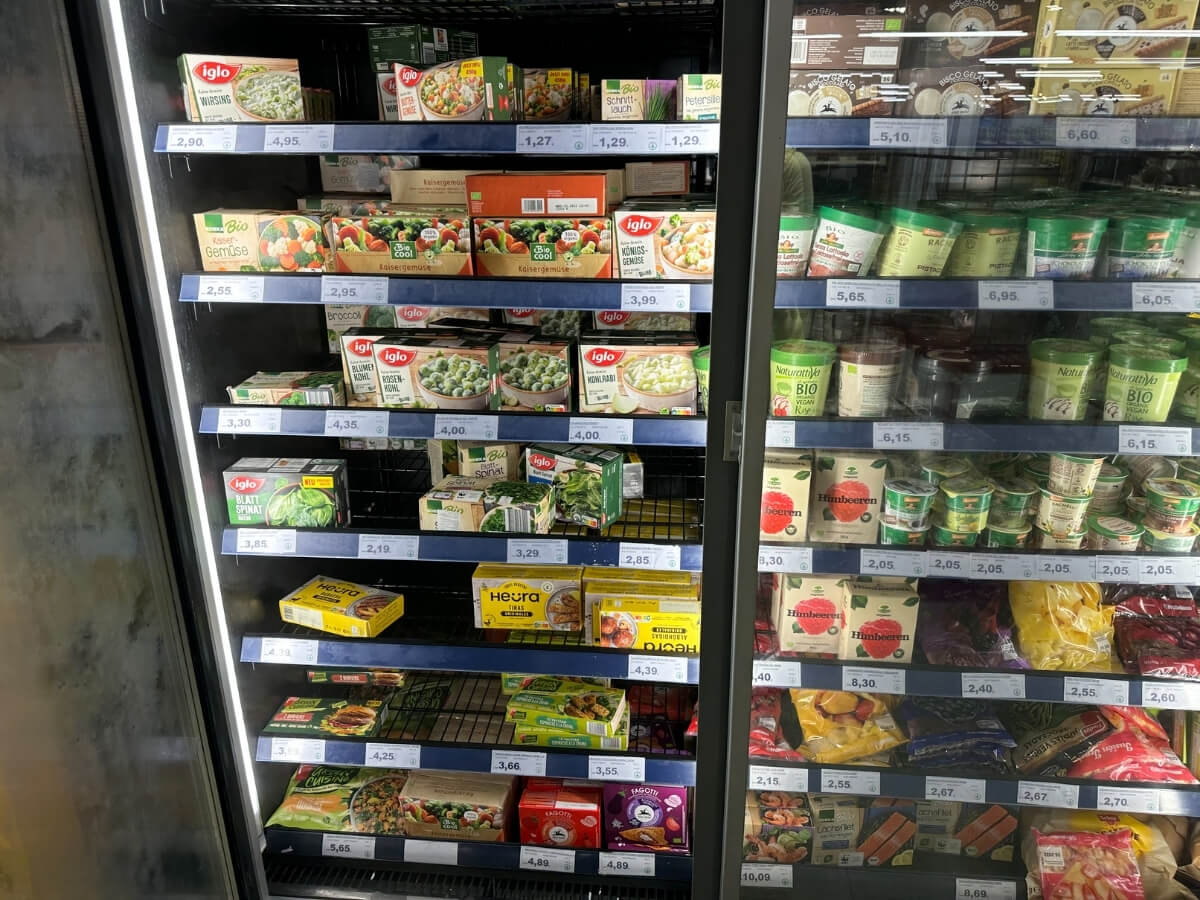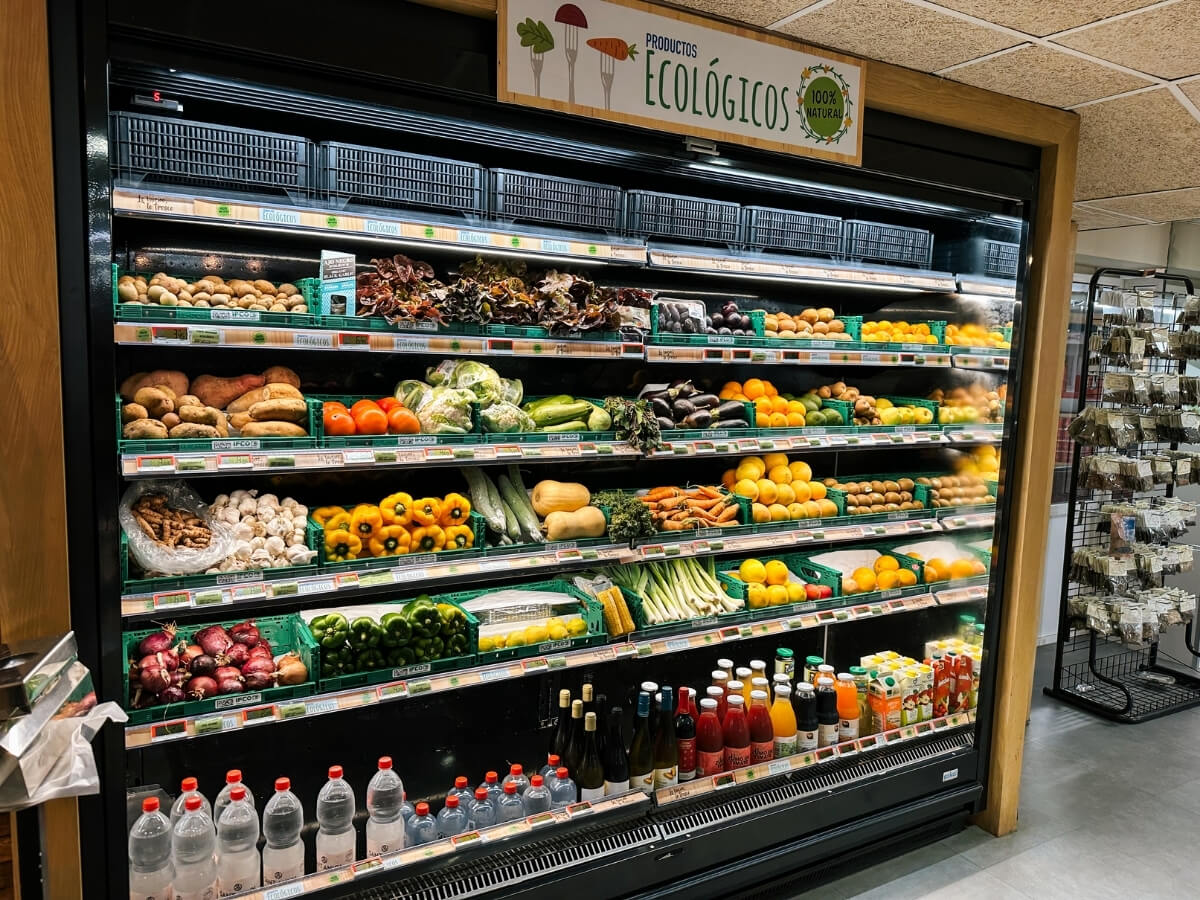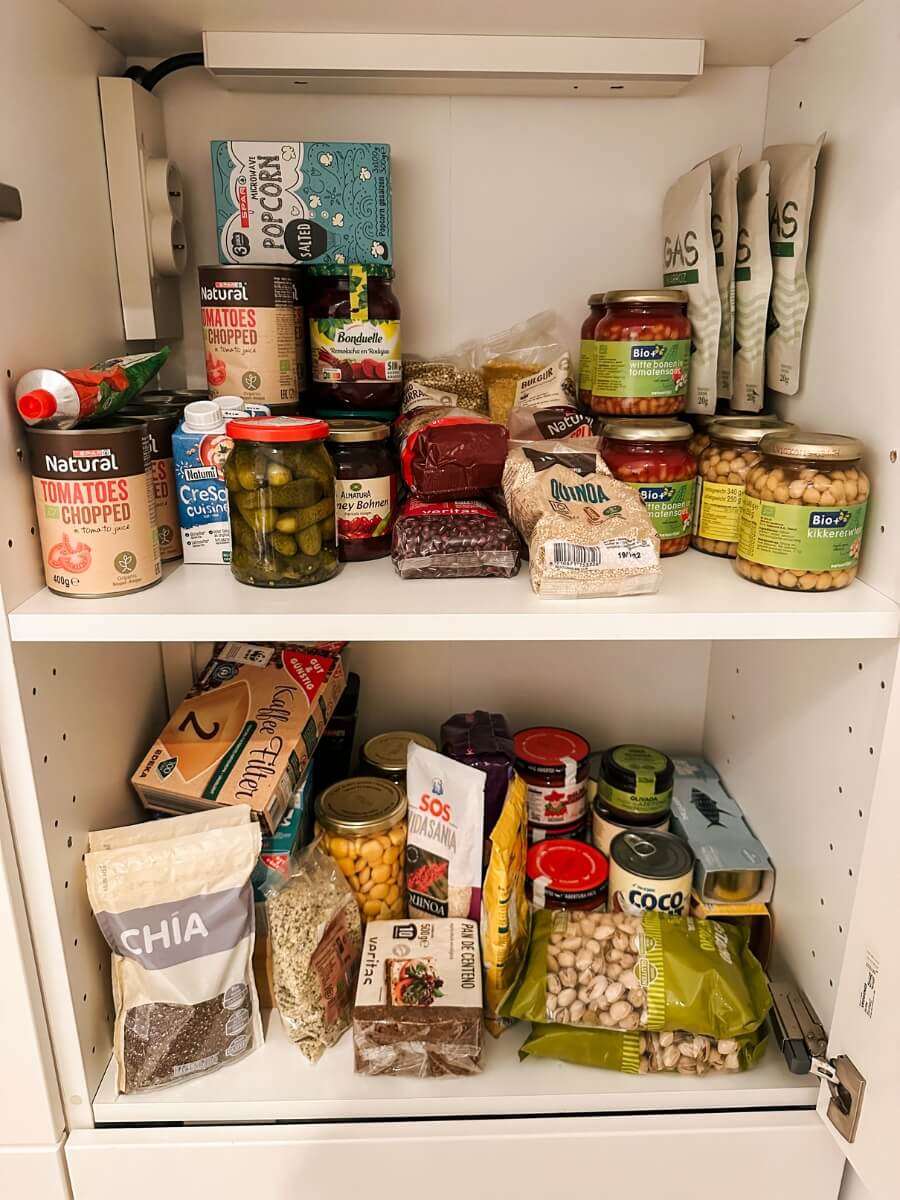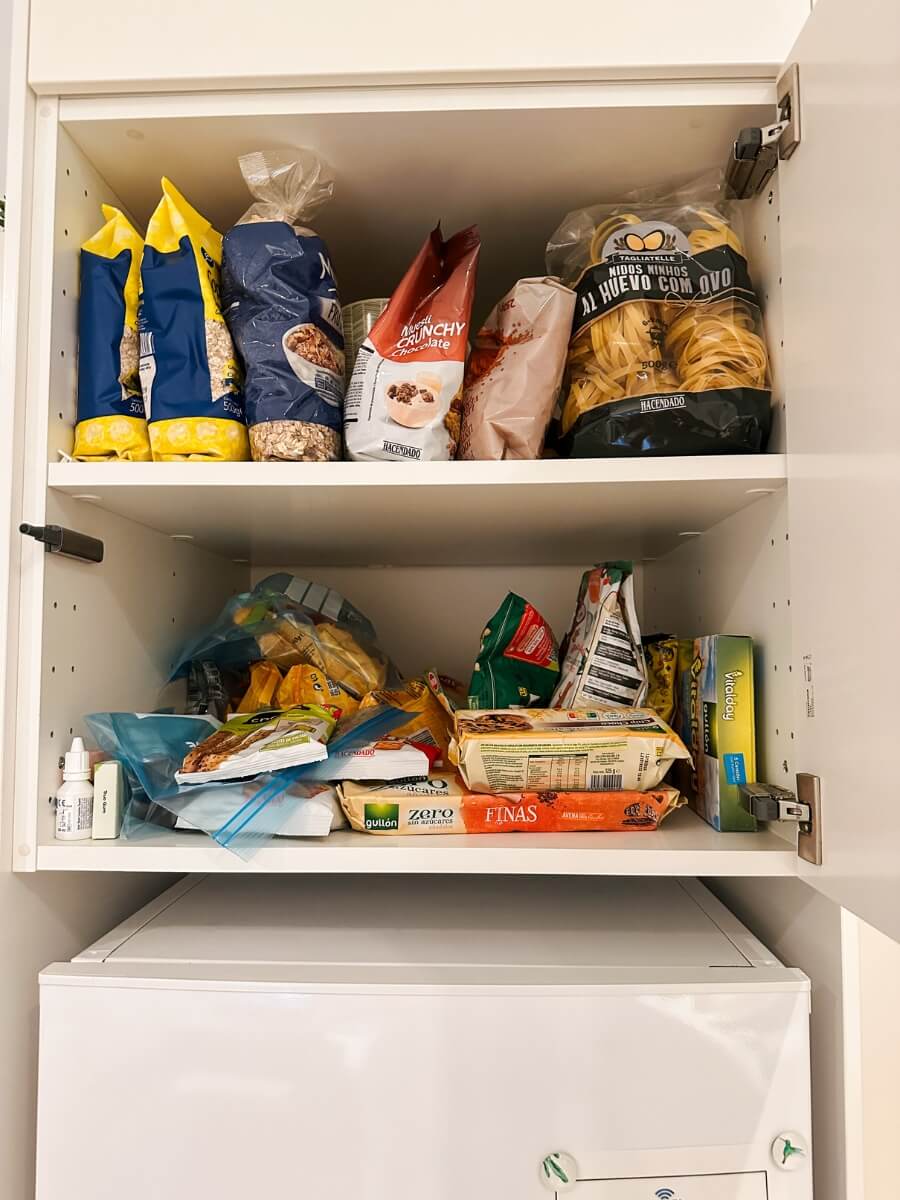Besides the sun and trips, we love the food on this island! As for restaurant tips, we already mentioned some in the comprehensive article about Gran Canaria. However, you are more likely to find us in a greengrocer or grocery store rather than a restaurant. Their local fruits and vegetables are simply perfect. Read our tips on where and what we buy most often. 🙂
All prices are updated for 2023.
Stores in Spain are closed on Sundays, so be aware of this. Some shopping centers may be open, but grocery stores are generally closed. The exception is the Spar chain – but note that not all branches are open, so always check in advance on Google Maps.
Disclaimer: We are not sponsored or paid by any of the mentioned retail chains or stores.
Fresh Fruit and Vegetable Store: El Sótano
Frutería El Sótano – make a note of this name, and don’t even tell us if you visit Gran Canaria and don’t shop at this paradise at least once! We visited various greengrocers, but none compared to El Sótano – either we encountered overpriced products, or not everything was local and fresh. That won’t happen to you here…
We found this greengrocer by chance when we were staying long-term in San Agustín. Behind the counter sits the sweetest lady, Sara <3. If you want to chat here, you won’t get far without Spanish. They don’t speak English at all, but of course, it’s not necessary for grocery shopping.
If you know Spanish and plan to visit frequently, you will learn many interesting things here, and Sara will always be happy to chat with you. We came here every week, so it felt like home to us. 😊
Parking here can be a bit challenging as it is a residential area, and besides you, all the locals want to park here too. However, you will definitely find a spot, sometimes you may need to circle around a few times, but something will open up. Once you’ve parked near the grocery store, head straight to Spar – tips on groceries at Spar can be found in the article below.
So, what can you buy here? You will always find local and seasonal fruits and vegetables at very affordable prices. Here are the items we frequently bought and enjoyed the most, which are not commonly available fresh in our climate.
Passion fruit
Passion fruit – I have to say, we bought so many that Sara started calling me “la niña de maracuja” (the passion fruit girl). I used to buy passion fruit at home occasionally, and I was used to paying around €2 per piece. Here, everything is sold by the kilo, including passion fruit. Each piece ended up being ridiculously cheap, so we usually bought about 30 pieces at a time. Depending on the season, if Sara didn’t have many, she would always set some aside for us under the counter.
Here, I learned how to choose passion fruit in the store. In the past, I made the mistake of always picking the smoothest and nicest looking ones. But here, I found out that you should go for the most wrinkled passion fruits. These are the ripest and best. I use this trick at home in Slovakia, too, and always end up with sweet, delicious passion fruits.
Guayabo
You might know this fruit better as guava, but here it’s called guayabo. I don’t think I’ve ever seen it in stores at home, and if I did, I probably overlooked it because I wouldn’t have known how to eat it. I only discovered it here two years ago and had ignored it before.
I’ve seen two types of guayabo here – one with green skin and one with yellow skin, each with differently colored insides. When I first tasted this fruit, it immediately became my favorite, replacing my beloved passion fruit.
If I had to describe its taste, I would say it’s like a mix of banana, kiwi, and strawberry quite unusual, right? The most interesting part is the texture; the flesh is semi-soft and becomes creamy when chewed. This fruit also comes with a great story that will help you understand how different the Canary Islanders’ mentality is from ours.
A short story
Whenever we shopped, we always asked about certain types of fruit or vegetables, how to eat them or what to use them for. The same happened when they had large crates full of guayabo. There was already a long line of people behind us, so I took two pieces to try and asked Sara how to eat them. At that moment, she got off her chair, went to wash her hands, took a knife, and started showing us everything.
I began to get nervous because there were so many people behind us, and we didn’t want to hold up the line. You can imagine the grumbling in Slovakia if someone started chatting and held up the entire queue. Be honest, wouldn’t you roll your eyes too?
I was the only one nervous; everyone else was in a good mood and perfectly fine. Sara started explaining that you just need to wash the fruit, cut a bit off the ends, and you can eat the whole thing, skin and all. Just chew it, and even the seeds inside are edible. Yum, the explosion of flavors!
The amazing part of this experience was that the people I was worried about upsetting started joining the conversation. Everyone began giving tips on how they eat guayabo. One person throws it in a blender with milk and squeezed lemon to make a refreshing milkshake, another adds it to both sweet and savory salads. For us, this was a very pleasant experience, especially that no one minded the delay and that everyone contributed their own experiences.
Since then, we’ve always bought guayabo whenever it was available. The skin can sometimes be bitter, so we usually prepare it by peeling the skin and slicing it into rounds to take to the beach.
We also learned a trick from Sara to pick ripe guayabo, which only applies to the green-skinned variety. Look for yellow coloring on the green guayabo – these are ripe and ready to eat.
This fruit is known for its high antioxidant content, vitamin C, and fiber. Sara told us it’s very good for blood and heart health.
Prickly pear
This is Jany’s specialty, and he used to eat prickly pears (opuntia) the most. They are handled with tongs for a practical reason: they are covered with tiny spines that are very difficult to remove.
I don’t know if you’ll find a fruit with as many health benefits as the prickly pear. Their only downside is those spines and the slightly tricky preparation.
Sara and the other greengrocer staff gave us various tips on how to eat this fruit. Jany found the most effective method was to cut off the thicker end and then squeeze the narrower end, so the pulp easily pops out of the skin, ready to eat. He always held the fruit with a paper towel folded several times.
The second method is to make a lengthwise cut in the prickly pear and then use the edge of the knife to peel off the skin, and the prickly pear is ready to eat!
They usually had purple-pink prickly pears with the same color inside, but sometimes there were also orange-yellow ones, which are also excellent. We find the darker ones a bit better and more refreshing in taste.
Prickly pears are refreshing and really delicious! Don’t be afraid of their prickly exterior and give them a chance. Even if you get a tiny spine stuck in your finger, nothing will happen. Just bring tweezers, and you won’t have any problems!
Mango
We also buy sweet mangoes by the kilo here. The taste of mango in Spain is completely different from what we are used to at home. Mango is in our basket with every purchase, and never just one 🙂 It’s excellent as a beach snack or a substitute for sweets.
Pitahaya
Pitahaya, known as dragon fruit, is also sometimes available here. We enjoy buying it occasionally and eating it by simply cutting the fruit in half and scooping it out with a spoon. Pitahaya is known as a superfood due to its high mineral and vitamin content.
Avocado
Avocados are in peak season in November/December, and during this time, they’re abundant in stores with a buttery flavor that’s simply divine. In the greengrocer, they were always by the checkout, and Sara would individually pick the best pieces for you; you just tell her how many you want.
Whether you enjoy avocado with just salt and bread, as guacamole, or in another spread, the taste of Spanish avocados is unparalleled.
Their price can vary significantly depending on whether they are in season and how many are available (this price change also applies to regular stores).
Bananas
It wasn’t until we were in the Canary Islands that we realized we had never really eaten proper bananas. Canary bananas or “plátanos canarios” are so sweet that you won’t be able to get enough of them! So, definitely take at least one bunch, and you’ll find yourself going back for more.
Papaya
Papaya, though not usually our favorite fruit, is also sold by the kilo here and often for just a few euros. It’s an excellent beach snack. We often sliced it into a box along with guayabo and had a refreshing fruit salad on the beach.
If you don’t know how to eat papaya, cut it lengthwise and scoop out the black seeds. The seeds are not edible, so discard them. Scoop out the orange flesh with a spoon and enjoy.
Oranges
Here you’ll find out that there isn’t just one type of orange! They sell oranges for eating and oranges specifically for juicing. In our opinion, they taste almost the same, but it’s true that the juicing ones have much more juice. Either way, be sure to pick some and enjoy the fresh taste of oranges.
Tomatoes
Tomatoes are also categorized for salads and sauces. Choose large, meaty tomatoes; they are our favorites and, with a bit of olive oil and salt, make an excellent light snack.
Be sure to visit at least once during your vacation and stock up on fresh fruits and vegetables, you definitely won’t regret it!
Mercadona
Besides local fruit and vegetable shops, Mercadona is our favorite supermarket. We fell in love with it during our Erasmus stay in Málaga. This store will charm you with great prices and excellent food.
We go there very often and have our favorite Mercadonas: one is in Meloneras (we also recommend taking a walk here; there are beautiful houses, and this area is considered the “wealthy district”), and the other is in Puerto Rico.
Every Mercadona has larger baskets or more compact smaller ones, depending on the size of your purchase. There is no need to insert a coin, and they are freely available.
If you need to use the restroom while shopping, each Mercadona has a WC, labeled “Aseos”.
Mercadonas always have parking available in front of the store or an underground garage. Parking is free. There is a one-hour limit (this applies to underground parking where you take a parking ticket). You get 2 hours free if you spend more than €20, and the parking will be validated at the checkout. We have never stayed longer than an hour, so you don’t need to worry about parking!
In this section, we’ll reveal what we always buy and the prices you can expect. Mercadona has its own brand, Hacendado, and many of their products are among our favorites. You don’t need to weigh fruits and vegetables; they will weigh them for you at the checkout.
Fruit a vegetables
Our first stop in the fruit and vegetable section is always at the fresh orange juice machine (zumo de naranja). This is a machine for making fresh juice, with options for 250 ml, 500 ml, and 1-liter bottles. We always buy the 1-liter bottle. You operate the machine yourself and simply fill your bottle with fresh juice. What surprised us, however, was the fluctuating price of this drink: one month, a liter was €3.50, and the next month, it was €5.50.
We couldn’t resist asking the sales lady if this was due to inflation or what caused the rapid price changes. She laughed and told us it was due to the orange season. Didn’t you think of that? Indeed, when oranges are not in season and scarce, the price goes up. Well, we swear that even at €5.50, this juice is worth it; these are just different oranges, and the term “fresh” takes on a new meaning in this case.
We buy most of our fresh vegetables at the local greengrocer, so we don’t buy them here very often. However, everything we’ve ever bought here has always tasted great. For example, the bananas from Mercadona taste better to us than those from the greengrocer. However, it always depends on the season when you come here.
There is a wide variety of leafy salads here, and what always pleases me is that they have large packages of kale. Not our usual kale, but “kale”; in Slovakia, I’ve mostly seen it only in Yeme, and they sell it under the name curly kale. It’s not the tastiest leafy vegetable in the world, but it’s very healthy, and we make kale chips from it.
What’s really worth buying here are avocados; look for the ones packed in boxes of 3 or 4. They cost around 3€, and they taste like butter, yum.
If you don’t feel like making guacamole or want to buy a quick snack for the beach, get a box of ready-made guacamole. It’s really excellent, and we always have it in the fridge for sudden hunger. A smaller 200 g pack costs 1.75 €, and a larger 500 g pack costs 3.50 € (we always buy the larger one).
In this section, they always used to have dried tomatoes, but on recent visits to Gran Canaria, I haven’t seen them on sale at all. Again, this could mean that it wasn’t the season or there was some shortage. When I say we used to buy 10 at a time, I think it’s clear how good they taste.
Bakery
The bakery in Mercadona is very cheap, and they often have packs of baguettes, 5 for 1 €. We don’t buy much bread here, but we do have our favorite – butter croissants! They are excellent, whether for breakfast or as a snack on a trip.
Chilled section
If you like cheese, you’ll be in heaven. We didn’t take photos of this section because it’s not something unusual, and everyone can choose according to their taste. We always buy Parmesan, mozzarella, and sheep’s milk feta. There is also a wide selection of goat cheeses with various flavors at great prices.
From the beach snack category, we often buy hummus for 1.45 €, and that hummus is really excellent. We’ve tried all the flavors, and they are all great, so choose according to your mood. We most often take the red one – hummus pimiento.

Fish
Fish is a separate chapter; there is a large section with fresh fish and other seafood. If you’re a lover of various seafood, you’ll definitely enjoy it here. In this section, there is always a very nice staff who are always ready to advise.
Right next to this section, there is also a classic shelf with pre-portioned fish; we can recommend the salmon. It’s really excellent, fresh, whether you’re grilling it, baking it in the oven, or making a poke bowl. You can buy a large piece of fresh salmon for about 7 €.

Frozen Section
If you like fruit porridge for breakfast, head to the frozen section. They have excellent frozen fruit that is very affordable. 300 grams of strawberries cost 1.60 €, blueberries 2.50 €, and a fruit mix 1.65 €. The bags are resealable, so they are easy to store and will last you the whole vacation. But before buying, check if your accommodation has a freezer 🙂

Drinks
Water
Drinking tap water is quite a controversial topic in Gran Canaria (and generally for all the Canary Islands). The water is drinkable, and you can find this information on various official sources online. However, the locals will tell you not to drink it. They explain that in the past, there were various problems with the water and its filtration, so they do not recommend drinking it.
I hate buying a lot of plastic bottles and thus unnecessarily contributing to more plastic waste, but really everyone has always told us not to drink the water. We use it for cooking and making tea, but for regular drinking, we bought bottled water.
Fortunately, you can buy water in large 8-liter bottles, which last quite a long time, and you can refill smaller bottles for the beach or trips. Water is not expensive, and you can buy an 8-liter bottle for 1.10 €. We tried to choose local water from the Canary Islands.
For small bottles (1.5 liters), we bought our favorite brand, Solan de Cabras, not only because it is tasty water, but their bottles are really beautiful and easy to drink from.
Juices
Even though we don’t drink much juice at home, we love it here! You can find juices that contain no sugar and are made only from fruit. They serve as excellent refreshment in hot weather. Among our favorites from Mercadona’s Hacendado brand are these flavors, which you can buy for 1 liter at prices ranging from 0.80 € to 1.20 €:
- Multivitamin (we haven’t seen these in any store during our last two visits to the Canary Islands, so we don’t know if there was just a shortage or if they stopped making them)
- Peach and grape (melocotón y uva)
- Pineapple (piña)
- Pineapple and grape (piña y uva)
- Tropical (tropical fruit mix)
- Guava (the aforementioned guava can also be bought in juice form)
- Passion fruit
Don’t miss the smoothie section here, we love these! We always have a few in the fridge and often take them to the beach as a refreshing treat. The smoothies are cold-pressed, so they retain more vitamins. You can see the ingredients in each photo, showing that they really contain nothing unnecessary. You can find them in the chilled section, and our favorites are:
- Smoothie Fresa (jahoda, jablko, banán – cena 1.60 € za 250 ml)
- Fresh Maracuyá & chia (jablko, chia, mango, banán, marakuja – cena 2.75 € za 750 ml)
- Fresh jengibre & manzana (jablko, zázvor – cena 1.10 € za 250 ml)
- Active ginger (malý jablkovo-zázvorový shot – cena 1.35 € za 60 ml)
Milk
We only buy plant-based milk, but you have a wide variety of different kinds to choose from, so you won’t have any problems. Among plant-based milks, we most often bought almond and rice milk here, but later we found higher quality and better plant-based milks in Spar (you can read these tips below in the Spar section).
Bebida de chufa and Horchata de chufa
We tried this drink only once and saw that locals buy it very often, so we wanted to test it too.
Have you never heard the word “chufa” (pronounced “choo-fah”) and can’t identify what it is from the picture? Don’t worry, you’re not alone; we didn’t know chufa either. In Slovak, chufa is šachor jedlý, but it’s commonly known as tiger nut or earth almond. In English, it’s called “tiger nut.” It is a tuber that looks like a dried nut.
This drink is a type of plant-based milk; it most closely resembles almond milk to us. Tiger nut is rich in fiber, minerals, and is also a strong source of vitamins B, C, and E.
Locals told us that horchata de chufa is best served chilled and is drunk during hot days. To experience the taste of Spain, try chufa at least once and make your own opinion.
Canela & limón
This cinnamon-lemon milk was a big hit here. We never tried it, but we have to mention it in the article because we noticed that all the locals always had it in their shopping carts. Although the idea didn’t appeal to us much, if you want to try what the locals drink, give it a try for us. We’d be happy if you let us know in the comments whether you liked it or if we shouldn’t bother tasting it.
Pivo
When you’re in Spain, be sure to buy Spanish beer! Among our favorite brands are San Miguel (small can for 0.62 €), Victoria from Malaga (small can for 0.59 €), or the refreshing radler by Tropical (small can for 0.65 €). They usually offer discounted prices if you buy a larger pack of 6 or 8 cans.
Remember the Tropical brand, it’s a Canary beer produced right in Gran Canaria and Tenerife.
Rum
We don’t drink rum, but we have to include this recommendation since the Arehucas brand has a factory in the town of Arucas on Gran Canaria. If you visited the factory with a tour based on our recommendation, you already know this rum. You can buy it for cocktails or as a gift to take home. You can buy the classic dark and white rum directly at Mercadona, and the rarer aged rums directly in Arucas, in specialized stores, or even at the airport (though with a markup). A 1-liter bottle of dark or white rum costs 11.30 €.
Sangria
Have you really been to Spain if you haven’t had sangria at least once? Every store has a huge selection.
Sweets section
Turrón
In the sweets section, you will find large shelves full of turrón. This is a typical Spanish sweet that you should try at least once, and it also makes a great souvenir. It’s somewhat similar to turkish honey with various flavors.
For us, turrón is quite sweet, and a bite is enough, but those with a sweet tooth will surely enjoy this treat. Classic varieties include Turrón Duro with almonds, and a twin pack costs 2.55 €.
Nuts in Chocolate
These chocolate-covered nuts are addictive! They come in various types, and our favorites are walnuts in milk chocolate (1.90 €), almonds in dark chocolate (1.80 €), and peanuts in milk chocolate (1.66 €, they also come in dark chocolate).
Other Groceries
Cereals
You’ll find a wide variety of cereals here, from well-known brands to Mercadona’s own products. We most often buy plain oatmeal (copos de avena) and chocolate-hazelnut pillows (chocolate & avellana – second to last shelf on the left in a dark package).
Olives
A Spanish setting without a proper selection of olives hardly exists; it’s all about your preferences here. We buy larger packs of pitted olives, which we use in pasta sauces. For higher-quality olives for salads or just as a snack, we get them at Spar.
Plant-based “Babybel”
What? Plant-based Babybel cheese? What are we talking about?! We first discovered this legume at a market in Málaga and have loved it ever since. Until recently, I hadn’t seen it anywhere in Slovakia, but now it’s being sold at Yeme in the chilled section among the olives. That’s a tip for you if you want to find it back home.
Altramuces translates to lupin beans and is often compared to soybeans, but its taste is quite different. At Mercadona, you can buy it in a 440-gram glass jar for 1.30 € (enjoy this price because, at Yeme, you’ll pay four times as much for a much smaller quantity). You consume it by popping the inside out of the skin between your teeth. It really resembles a cheesy taste, and we call this legume Babybel due to the similar way you open it.
To make it even tastier for you, know that it contains a high amount of protein, few carbohydrates and fats, and is gluten- and cholesterol-free.
Jams
We never bought jams because we have a supply from grandma’s garden. But if you like sweet breakfasts with jam or want to bring home an original gift with local flavors, be sure to check out this section. We recommend choosing guava or fig flavor at a great price of 1.70 €.
Dried Figs
The dried fruit section here is rich, and our favorites are these figs. The figs are coated with a thin layer of flour, which is typical for Spain. At the markets in Málaga, we were told that this is a specialty of Málaga, though we may never know the exact origin. Try buying one package to taste. We always buy them to take home. The price is also very good, and a 500-gram package costs 2.15 €.

Dried Pineapple
It’s a smaller package, but these dried pineapple rings are excellent. We recommend taking them as a snack to the beach. It costs 1.40 €.
Pistachios
Pistachios are our beach staple; the best price and taste we found are in these at Mercadona. A 300-gram pack costs 3.60 €. There is also an unsalted version; we gave it several chances, but it’s not quite the same. These are the best, and on the beach with a sea view, they taste even better.
Grilled Peppers
Pimientos asados are grilled red peppers, an excellent treat. Our recommendation is to enjoy them on bread with butter, yum!

Seaweed
If you’re in the mood for a healthier snack, try these dried seaweeds. They are packed with vitamins and have a unique taste, making them a great healthy treat. A super tip is to crumble them into your salad.
Nachos
If you’ve already picked up some guacamole, be sure to grab some nachos to go with it. This snack is perfect for the beach or for evening movie watching.
Nachos Sauce
Besides guacamole, these nachos pair well with Salsa Mexicana. It’s a mildly spicy tomato sauce and is delicious.
Olive oil
Our first stop upon arriving on the island is always Mercadona, where we stock up on basic cooking supplies. Olive oil is a must on our list, and it’s available at a great price of 4.30 € for 1 liter.
Canned Goods
Canned fish lovers will be in heaven here, with a wide variety available. Try all your favorites, as they can be bought at great prices. We most often buy plain tuna.
Locals highly recommended trying mejillones (mussels). Jany loves them, and we made them with pasta. I’m not a big fan of mussels and such, so this product didn’t win me over.
Drugstore
There’s also a large drugstore section where you can stock up on any items you forgot or are missing. Everything here is very affordable, and you won’t have trouble finding what you need. If you need a respirator or protective mask for any reason, you’ll find them in this section as well. A pack of 3 FFP2 respirators costs 1 €.


Christmas
If you find yourself at Mercadona during the Christmas season, you’ll see plenty of Santas, but also panettone and pandoro. We thought panettone was mainly popular in Italy, but during Christmas, almost every local had one in their cart.
Take a closer look at the advent calendars, as in Spain, the biggest holiday is on Three Kings Day, so the calendars have a few extra windows and end on January 6th.
Traditional Spanish Cookies:
These individually wrapped cookies can be compared to our tea biscuits but are a bit fluffier. You’ll see them mostly during the Christmas season, and they come in various flavors. To be a true Spaniard, you should try every kind. They are sold by weight (5 €/kg) – just fill up a bag with as many as you want, and at the checkout, they will weigh and price them for you.
Christmas Opening Hours:
For your convenience, we took photos of the opening hours during the Christmas holidays.
Payment
After shopping and reaching the checkout, if you forgot your bag, you can buy a reusable bag for 0.65 €, which is always hanging by the checkout. If you don’t want to buy it, you can ask for a regular plastic bag for a few cents by saying, “Una bolsa, por favor.”

Spar
We often shop in multiple stores back home because we have our favorite and trusted products in each one. Therefore, shopping on Gran Canaria is no different. In Spar, we have our favorite organic and plant-based products and other cool items.
We most frequently visit Spar in Puerto Rico, which is right across from Mogan Mall. This Spar is very nice and even won a design and architecture award in 2020. This Spar is also connected to Spar Natural, which has a large selection of organic products.

Our second favorite large Spar is near the produce market, so when we go to El Sótano, we always visit here as well.
Part 1 – Photos from Spar in Puerto Rico
In Puerto Rico, you’ll find the parking lot entrance right in front of Spar, and you get an hour and a half of free parking.
La Frutería

Welcome to Spar in Puerto Rico. Right at the entrance, you’ll be greeted by beautifully arranged fruits and vegetables. I absolutely revel in this! Everything is always neatly organized, and you can see for yourself from the photos, where you can also check the prices of individual products.
Orange juice
Jany’s must-stop! We always buy juice wherever we go. The price is comparable to Mercadona, usually with no significant difference. Jany thinks the juice from Mercadona is slightly better.
Guayabo
Here’s how to choose ripe guayabo (guava). Aim to buy guayabo that is yellow and can be a bit shriveled – exactly like the ones at the bottom of the box in the picture.
Papaya a avocado
Don’t forget to add a papaya and a few avocados to your basket!
Cheeses
The cheese section, Cava de Quesos, offers Spanish and local cheeses, as well as products from around the world.
Look for the white-blue-yellow Canary Islands flag on the products, indicating local products from Gran Canaria.
The cheese selection is vast, providing plenty of options. Be sure to try the goat cheese, which doesn’t have the typical “goaty” smell and tastes great with tomatoes or olives.
Olivy
Speaking of olives, I mentioned them in the Mercadona section, but for high-quality and delicious olives, I prefer these vacuum-packed ones in Spar. Each pack is about 400 grams and costs around 2.50 €.
Fish
You’ll also find a large selection of fresh fish and seafood.
Beer
Beer deserves a separate section here, as it has its own area called Cava de Cervezas. You’ll find a selection of local and international beers of various types and flavors.
An interesting feature is the beer section where you can pour your own beer, either into a glass or a bottle. Here, you can tap craft beer from the brand Growls, which is local and directly from Gran Canaria.
Bakery
We usually buy bread at Spar, whether baguettes or rye bread “pan de centeno”.
Ask the lady at the bakery counter to slice the loaf for you, say this: “Por favor, puede cortar el pan?” (pronounced: “Por favor, puede kortar el pan?“).
Organic section – Spar Natural
Chocolates
We favor chocolates from the brand Chocolates Solé; we buy classic dark, milk with coconut or orange, and dark sweetened with agave. They also offer vegan chocolates; we have tried the brand Veganz.
Veggie products
You can also choose from many vegetable products, whether in the chilled section or organic products.
Part 2 – Photos from Spar in Maspalomas
Of course, you can find most items in other Spars, but we have divided the photos because some (especially items from the organic section) are only available here.
This store is divided into two parts; in the upper part (where you enter) are regular groceries, and on the right side, there is an escalator that takes you to the basement with a large selection of organic products, fruits, vegetables, and toiletries.
Groceries on the 1st floor
Salt
If you haven’t had the chance to visit the Salinas de Tenefé salt farm, you can also buy their salt directly at Spar. If we were to recommend just one, which is highly praised for its high vitamin content and health benefits, it would be flor de sal.
You often find various double packs here, and we definitely recommend buying them as gifts.
When we were on the island for a longer period, we bought a larger package of salt from Agüimes Salinas Bocacangrejo.
Gofio
A typical type of flour, Gofio, is a staple in every proper local household. Gofio is a traditional Canarian flour made from whole cereal grains roasted before grinding. You’ll most commonly see gofio made from corn nowadays, but originally it was made from barley. Gofio is rich in nutrients and historically helped residents overcome famines. There’s even a demonstration at the museum in Las Palmas showing how gofio was ground.
Spices
Check out the selection of spices; you can buy small boxes of spices for paella or directly for fish here.
Turrón
There’s a wide selection of turrón here as well; choose according to your preferences.
Sunflower seeds
You might have noticed locals cracking sunflower seeds while walking or relaxing on the beach. This phenomenon is also observed in other parts of Spain, but the Canarians have taken this hobby to another level. You’ll find beautifully packaged Canarian sunflower seeds here, with a paper pouch attached on the other side for discarding the outer shell. It’s also a great gift idea to bring home. A classic salted pack costs €1.40 and unsalted costs €1.45.
Milks
The selection of milk here is truly enormous, so you won’t have any trouble finding your favorite.
We usually buy Yosoy brand; our favorites are unsweetened almond milk (€1.95) and oat milk with calcium (€1.55).
Water
If you’ve never had Vichy Catalan water, be sure to try it. Sometimes you can find it at Mercadona, but it’s always available at Spar. You’ll recognize it by its distinctive glass bottle, and 1 liter costs €1.24.
We also buy local water from Teror – Aguas de Teror.
Beer
You won’t have trouble finding your favorite beer at Spar either. We’ve already mentioned our favorite brands in the Mercadona section.
Organic Section + Other Foods in the Basement
Teas
I recommend trying some teas from the Tisana Bio brand; they have various excellent herbal and fruit teas.
If you suffer from painful menstruation, I recommend this tea. It has sometimes helped me relieve pain, and generally, I’ve felt better after drinking it.
Check out the selection of dried leaves and teas; some are suitable for infusions, depending on what you’re looking for.
Juices
Try freshly squeezed carrot or peach with aloe vera; it’s a refreshing and very healthy drink. If you want a larger volume of juice, go for the Veritas brand and their carrot juice; 1 liter costs €3.85.
Dried cactus powder
If you enjoyed prickly pear and want to enjoy its health benefits at home, you can buy dehydrated prickly pear powder. We noticed that the price varies significantly in different Spars. For example, in Spar in Puerto Rico (a tourist area), the same bag costs €20, but here it could be bought for €16.35. It’s not cheap, but it lasts a long time, and you can add it to smoothies, porridge, or just mix it with water.
You’ll find it in a locked cabinet along with vitamins; just ask a staff member to open the cabinet.
Frozen section
From the frozen section, we tried some vegan ice creams; they were more expensive, but it’s manageable once in a while 🙂
Chilled Section
Here, we often bought tofu and vegan Violife spread, which we knew from Austria. Otherwise, we recognized many products and brands from Kittsee in Austria, where we also buy these products.
Sweets
Vegan chocolates, candies, protein bars – everyone will find something for themselves here.
Organic Fruits and Vegetables
I have to note that organic fruits and vegetables are quite expensive here, and I think we never bought anything. We always preferred the offerings at the local greengrocer.
Canned Goods
We bought their Spar Natural brand for tomato soups and salsas; you will also find various sauces and a large selection of rice.
Package-Free Products
The offer also includes package-free products that you can take as needed, mostly spices, legumes, and nuts.
Fruits and Vegetables
Typically, beautifully arranged fruits and vegetables; we often bought salads, cucumbers, and tomatoes here. In Spar, a staff member who is near the vegetables has to price them for you.

Classic Biscuits
Of course, you will also find classic biscuits/tea pastries here, typically popular during the Christmas season.
Seeds
We recommend buying some seeds, whether for your own needs or as a gift. This stand is located near the escalator back to the upper floor. We bought all kinds of tomatoes, and they really thrived 🙂 We also bought banana and palm seeds, but we haven’t planted them yet.
Eggs
At home, we only buy organic eggs marked with the number 0, so we looked for them on Gran Canaria as well. We only found them at Spar.
Our Final Recommendation 🙂
If we had to give you just one piece of advice, definitely invest your money in local fruits and vegetables that are not commonly available at home and fill up on these vitamins!
If you’re curious about what our fridge and pantry look like during a longer stay, here are a few photos, and we wish you a good appetite!
